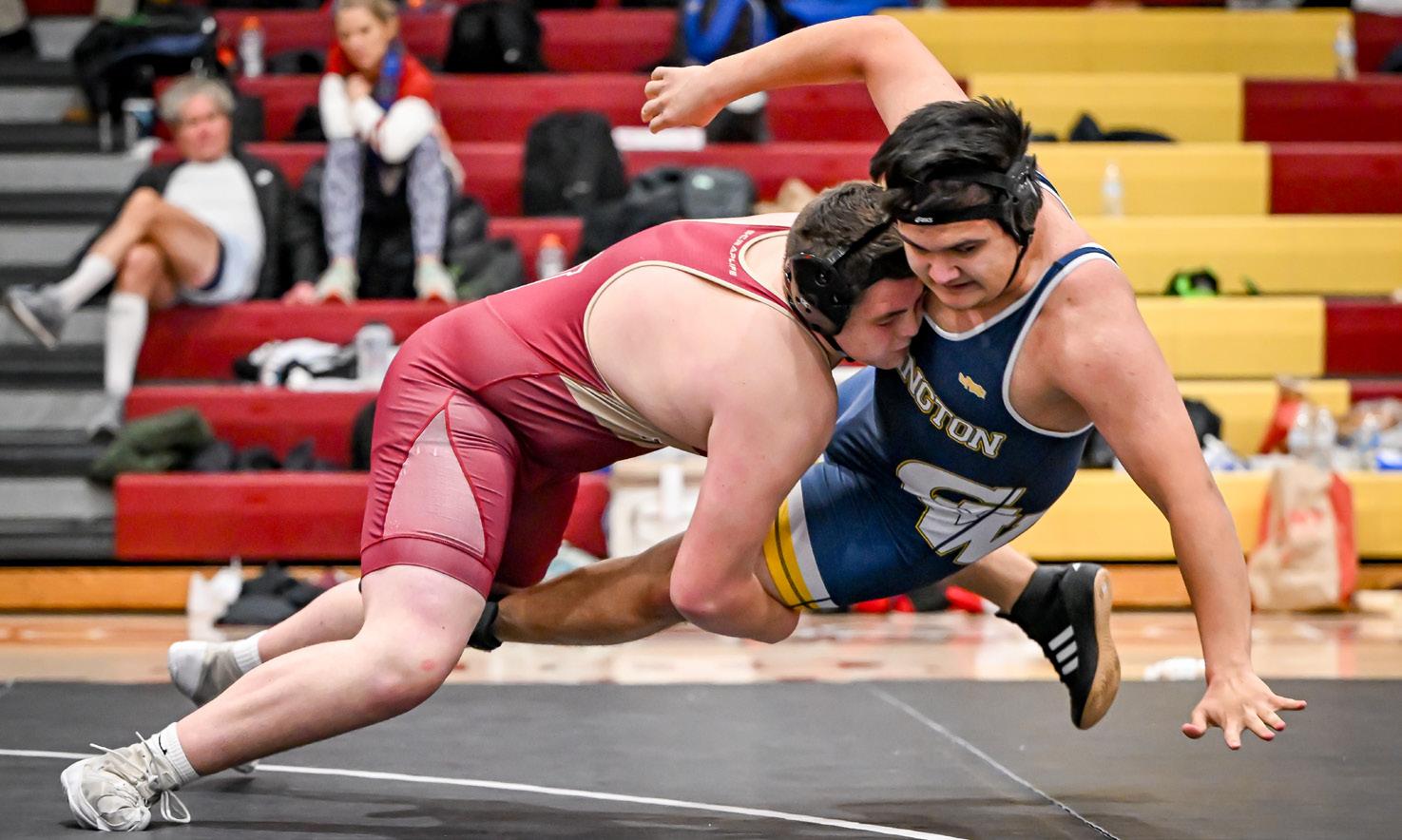the index





K.J. Carson ’25 distributes the ball in front of the bleachers that usually house the student section
Ian Rosenzweig ’25
Near-empty bleachers loomed over McBride Court as the Fords took on Germantown Academy in a Friday night game on February 7. Just ten hours earlier, Dean of Students Mr. Luqman Kolade, Director of Athletics Mr. Michael Murphy, and Head of the Upper School Mr. Mark Fifer informed the student body that the game would be played without a student fan section.
“The section is what makes Friday night games so special,” Sixth Form basketball player Gabe Baker said. “We definitely missed our guys.”
The decision to restrict fan attendance came after February 4th’s away game against Malvern Prep. Tensions between Fords and Friars were particularly high since a loss in football in October. “There was an interaction between large groups of both student
’25
From the classroom to the soccer field, History teacher Mr. Kevin Tryon’s commitment to inspiring students and athletes inside and outside of Haverford has had a tremendous impact. For his work in coaching, he was recently recognized with the Eastern Pennsylvania Youth Soccer Mike Barr Excellence in Coaching Award.
Mr. Tryon’s involvement with soccer is lifelong. He graduated from Franklin & Marshall, where he also played soccer competitively. While at F&M he was a three-year first-team all-conference selection and also a NSCAA NJ, PA, DE Region Team selection in those same years.
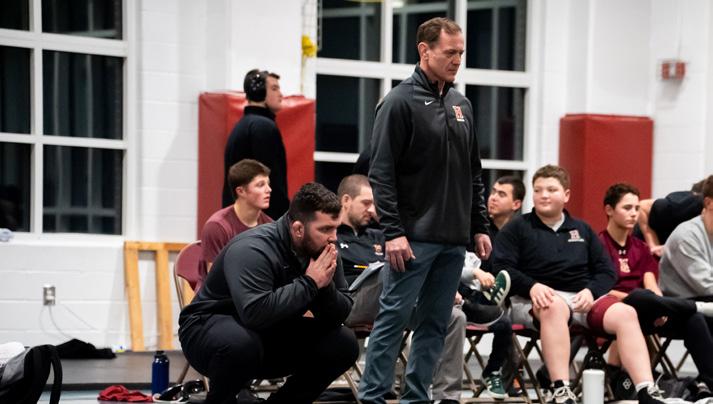
After college, he attended graduate school at the University of Chicago. He began coaching and teaching in 1987, first at Westtown School, before moving to Haverford in 2000.
Here Mr. Tryon has taught a variety of history classes. In his first two years he taught Modern World History in the upper school and U.S. History from 1865 to the Present in the middle school (fun fact: current upper school history teacher Mr. Timothy Lengel was one of his students).
cont’d on p. 7

bodies in the parking lot, and there was some profanity used, there was some provocative behavior,” Mr. Fifer said.
In response, Haverford and Malvern administrators and student leaders came together before Malvern’s trip to Haverford for a January 14th game.
Many students found that Malvern fans’ behavior—and administrative response—after the Friars’ win disregarded established
protocols. “Malvern stormed out on court… as they rained down the same insults,” Sixth Former Eddie Grant said. “[They] faced no punishment.”
However, students are not privy to all administrative actions; Mr. Fifer shared that Malvern did discipline members of its student body after the game on the 14th.
cont’d on p. 3
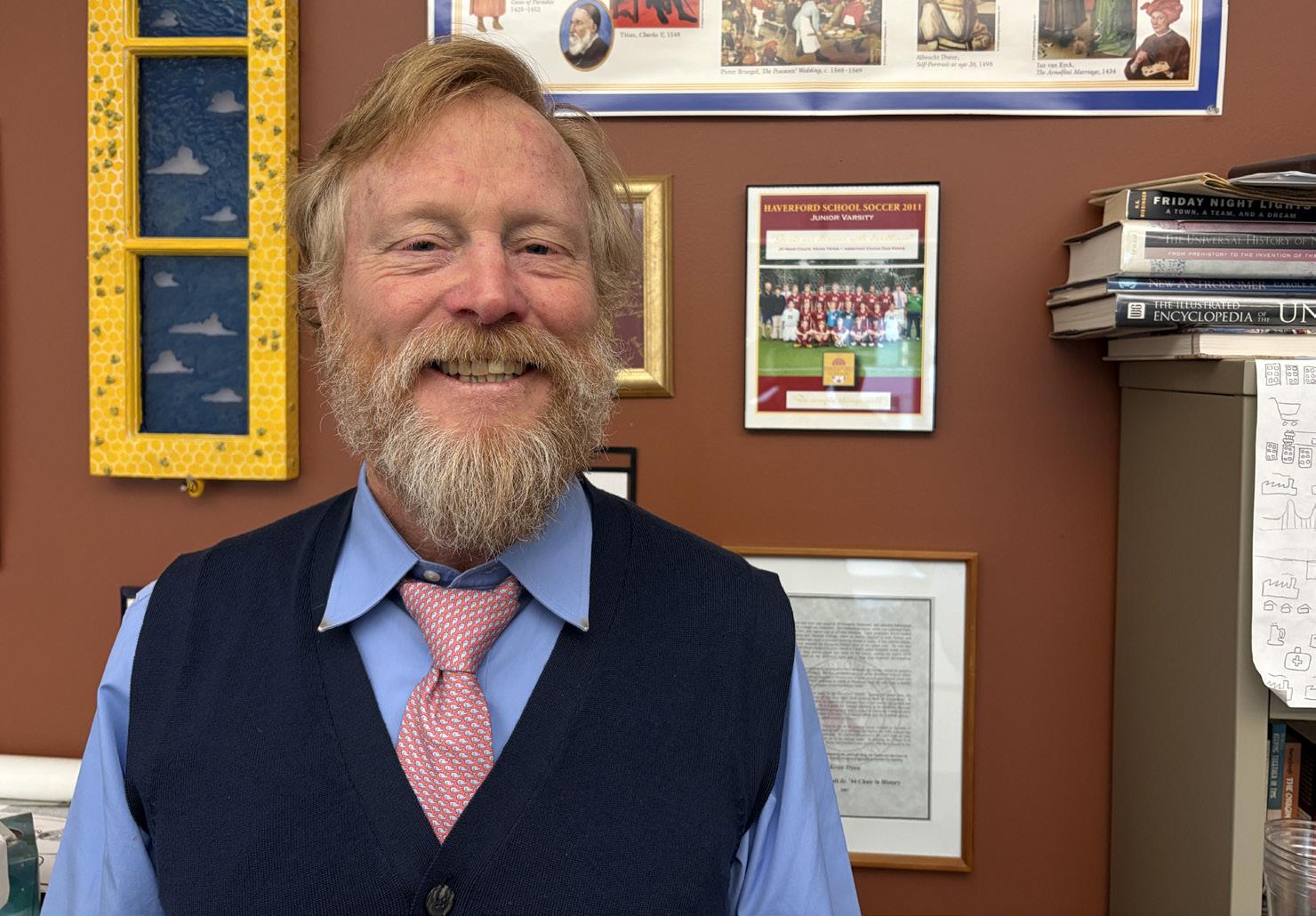

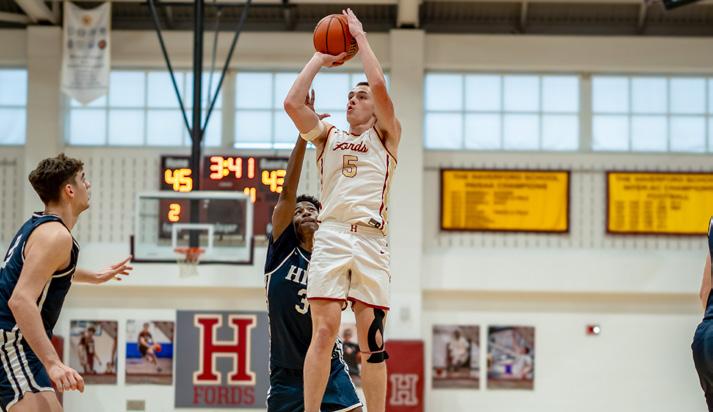
2024–2025 Staff
Ian Rosenzweig ’25
Editor-in-Chief
Connor Simpkins ’25
Editor-in-Chief
Elliot Lee ’25
Senior Managing Editor
Milan Varma ’25
Senior Managing Editor
Liam French ’25
Managing Editor
Abdullah Kanchwala ’25
Managing Editor
Tom Saul ’25
Managing Editor
Ajay Chakraborty ’26 News Editor
Ayush Varma ’27 News Editor
Ryan Wang ’26 Features Editor
Matt Lo ’27 Academics Editor
Adam Brown ’27
Neighborhood Editor
Ryan Hu ’26
Campus Opinions Editor
Peter McConnell ’26
Campus Opinions Editor
Grayson Morgan ’26
Off-Campus Opinions Editor
Michael Bartholdson ’25
Off-Campus Opinions Editor
Luke Ganley ’25 Arts Editor
Quinn Sullivan ’25
Senior Sports Editor
Nate Gill ’26
Junior Sports Editor
Charlie Schreiber ’26 Staff Photographer
Ms. Emily Harnett Faculty Advisor
Mr. Thomas Stambaugh Faculty Advisor
The Index is a student-run publication of the Haverford School that does more than bring news: it provides the diverse perspectives of the Haverford student body. It is an outlet for student writers to take stands on issues they deem important. It chronicles the daily struggles and accomplishments of the Haverford community. The Index also provides a forum for discussion of pertinent issues, such as student culture, academic policy, and Haverford’s place in world affairs. The Index presents new ideas and aspires to influence constructive change. All opinions and viewpoints expressed herein do not necessarily reflect those of The Index or the school. The Index is designed and produced digitally. Photographs may be retouched. Submissions and letters to the editors regarding any and all articles are welcomed at index@haverford.org
The Index, a member of the Columbia Scholastic Press Association, is composed using the applications of Google Suite and Adobe Creative Cloud. Its surveys are conducted via Google Forms and are advertised on email to current Haverford students. Graphic designs are created by Index staff via Canva. Southern Dutchess News prints 200-400 copies of each issue, and its editorial staff distributes them in the Upper School on the day of release. The Index serves the needs of a total school population of 1152 community members, consisting of 952 students and 200 faculty and staff members. Contact The Index: 450 Lancaster Ave, Haverford, PA 19041 index@haverford.org
Twitter: @Haverford_Index
Instagram: @Haverford_Index
Volume 92, No. 5 - February 13, 2024
We learn that others’ perceptions of our personalities should not inform our actions. “Be yourself” is a common mantra of parents encouraging their children to resist peer pressure and herd mentality.
But another influence is at work when you put on your maroon and gold or your jacket and tie. You are no longer just responsible for perceptions of yourself — you become Haverford.
Mr. Kolade shared a story at an as-
sembly about a Haverford student who was noticed in public for an act of kindness. Moments like that reinforce positive perceptions of Haverford. But we’re all aware of the negative stereotypes that follow us around, whether we portray them or not.
And so it becomes worthwhile to pause and reflect on our responsibility to those around us.
Our actions are primarily the results of personal character and decisions, but humility demands that we consider our impact on
our community. We are more than one person — we each contribute to the image that every Ford portrays.
Think of more than yourself. Understanding and managing perception is not a matter of caving to conformity; rather, it is a reflection of a commitment to high standards.
A unique balance between self-confidence and the humility required to represent a community exists — find it.


Fords, At the time of writing this, we just beat Malvern in basketball. A few weeks back, the Friars came into our house and soundly beat us. This made them so confident going into the rematch that they decided to make it a silent night. Bad choice.
They obviously didn’t know how strong our brotherhood is. Not only did we win, but we turned their “silent night” into a disaster. This was a great test of our brotherhood, but
we rose to the occasion and exceeded all expectations.
On a more serious note, we’re now in the second semester of our 2024-25 school year. February is a time where not much goes on at the school level. Stay consistent. It’s very easy to think that this time of year is just filler before the end. I encourage you to think otherwise. That mindset leads to things slipping.
Honor council cases increase around
this time because students will take their foot off the gas. With no gas, there will be no progress toward our collective goal. We have to keep doing our part as Haverford students to make this year go smoothly.
This means continuing to do the small and large things. Continuing to pick up trash, hold doors, support your brothers, and continuing to live with honor will keep this year going strong.
Thank you and Go Fords!
Student section absent, cont’d from front page
Nonetheless, a perception of injustice permeated the Haverford community, and February 4th’s game felt uniquely important to Haverford fans.
“No faculty member could understand how intense the Haverford-Malvern rivalry has gotten in the past year,” Grant said.
In preparation for a heated night, administrators set expectations for Fords fans. “We had some conversations with students about our expectations for them going into that game,” Mr. Fifer said. “We didn’t want them showing up in a provocative theme, we didn’t want them congregating before the game, we didn’t want them to rush the court if we ended up winning, and we didn’t want them congregating after the game given some of the problems at the football game earlier in the year.”
Mr. Fifer explained that the particular focus on large groups arises from studies into crowd mentality. “Crowd behavior is that people do feel more anonymous and don’t feel as accountable,” he said.
An email to the upper school student body from Mr. Murphy on the afternoon of the 4th reiterated expectations, which
another email had noted on January 31 in preparation for a home game against Springside Chestnut Hill Academy. “Reminder, that just as we have communicated about our home contests, there is to be no pre or post game gathering and entering or leaving venues en masse,” Mr. Murphy’s email read.
But, according to Mr. Fifer, post-game behavior did not meet the administration’s expectations.
“After the game, groups of students went out in the parking lot, they congregated in one place, and there was some profanity used,” he said. “It was just generally outof-control behavior that was problematic for us and was a through-line-pattern behavior from what happened in the fall at the football game.”
In response to that behavior, the administration chose to prohibit student attendance at all sporting events on February 7—a home basketball game, a hockey game, and a winter track meet —a consequence that has not been levied in recent years.
“On its face, the behavior would have been problematic,” Mr. Fifer said. “Contextualized with some of the previous behavior, it escalates some of the concern.”
the Malvern basketball game is the inconsistency,” Sixth Former Finn Tierney said. Tierney’s comment indicates a clear disconnect between administrators and students.
“Our standards and expectations really haven’t changed,” Mr. Fifer said. “What has changed is the behavior…large groups who are engaging in…profanity, being provocative, instigating—that’s the behavior that is new to us and that is most concerning to us.”
“It’s not a matter of the school changing its values,” Mr. Kolade added. “This is actually new behavior.”
Tierney, however, sees no such consistency.
“There doesn’t seem to be a set of rules that are clear for fan behavior, and no matter what the student section does it seems like there will be a punishment,” Tierney said. “Last year, blatant disregard for the rules led to just seniors being banned at a game. This year when we followed all guidelines set for us, we still ended up banned.”
and Mr. Kolade both came to me,” Williams said. “Afterward, Mr. Fifer came to me about it…I knew that [a consequence] was coming, so it wasn’t a shock.”
Regardless, many students are upset.
Grant believes that the administration should adapt to developing situations.
“It is not the administration going soft, but rather the school has not adjusted to the heat of the rivalry as well as Malvern’s administration,” Grant said.
Students seem to await a shift in administrative approaches, while the administration expects conduct compliant with current guidelines. Both groups recognize a need for stronger preparation ahead of future events.
“We have to come to a decision about how we want games to be going forward,” Williams said.
Mr. Fifer moves forward recognizing students’ dissatisfaction with expectations and consequences while affirming his commitment to school values.
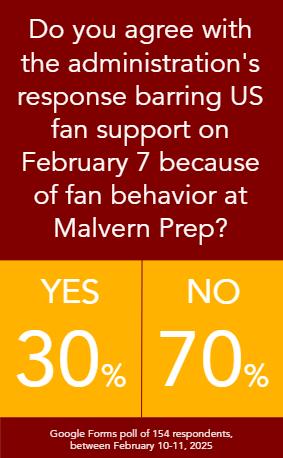

The administration sees current behavior as a new issue partially arising from professional sports fans. “Sometimes there’s a model that exists externally, in culture…how people behave at [Lincoln Financial Field],” Mr. Fifer said. “This is not the Linc, this is a school, and as such expectations for conduct are different.”
Mr. Kolade, Mr. Murphy, and Mr. Fifer each communicated the administration’s concerns to students at an upper school assembly. Each touched on a different theme, including the expectations of a school environment, safety, and consistency in standards amidst some students’ perception of the school having “gone soft.”
Reacting to the remarks, some students believe that the administration’s expectations and responses have not been uniform.
“The most infuriating and upsetting part about the assembly and the response to
Mr. Kolade disagrees. “I don’t think that the response was so out of line,” he said. “The difference between [the incident at a basketball game against Penn Charter last year] and this is that the kids understood what was wrong at the Penn Charter game, but here they didn’t see the problem with them hanging out and celebrating this win all together.”
Mr. Kolade has spoken to some students who understand the administration’s actions. “I did hear a couple of students who actually like what Mr. Fifer said about how he’s not going to let the standards at another school dictate our standards,” Mr. Kolade said.
Grant disagrees. “We can hold ourselves to a higher standard and that’s great, but this was not the time to enforce that,” he said.
Student Body President Josh Williams, whose position acts as a conduit between students and administrators, explained that administrators made clear that they were prepared for trouble—and subsequent consequences—surrounding the Malvern game.
“Before the Malvern game, Mr. Fifer
Emergency shelters always appreciate donations, but they do not always get the specific items they need. For example, socks are the most requested but least donated item in emergency shelters. In response to this, the Fourth Form Student Council organized a sock drive.
The Sock Drive was inspired by Fourth Former Will Mullin’s personal connection to the Joy of Sox, a local nonprofit, through his grandparents. The goal of this drive is to give new, unused socks, a small but key piece of clothing needed by people experiencing homelessness.
“We can always use more socks.”
RAY KRESGE ’27
“We came up with the idea because we wanted to do something charitable this year, and we had previous ties with this Joy of Socks charity,” Fourth Form President Ray Kresge said.
There are three donation bins in the upper school. They are located in the lobby af-
ter coming through the main entrance, outside Dean of Students Mr. Luqman Kolade’s office, and outside Fourth Form Dean Ms. Brooke Kenna’s room.
“We are hoping to get the three bins at least half full,” Mullin said.
“When we first started out, one of our first goals was to help advertise this drive. We have done that at assemblies and Form meetings. Right now, the student council thinks that numbers are a bit low and that we can always use more socks,” Kresge said.
The collected socks will be distributed through the Joy of Sox charity, which works with a network of shelters and outreach programs. These socks will provide warmth and comfort, helping to prevent foot infections and other health issues.
This drive aims to replicate previous successful service-orientated collections and make a meaningful impact on the lives of those in need.
It does not take much time or effort to buy and donate socks. Amazon offers a 12pack of socks for $14.99. Each pair of socks donated will provide warmth, comfort, and dignity to someone in need, helping to improve their daily life and overall well-being. Anyone purchasing and donating socks will bring hope and relief to many people across the country.
“[The future plan is] ongoing dialogues with students,” he said. “There’s also going to be some conversations with other schools to try to establish some shared expectations for student conduct so that there’s some coherence and consistency across the board for expectations for fan conduct at athletic contests. I think that there will be some direct conversation and dialogue with Malvern Prep…on how the schools can partner to have some shared expectations for student conduct.”
Williams believes that, beyond dialogue, direct action can be taken to prevent problematic behavior from students across the Inter-Ac league.
“We should be more proactive on how we defend our place, and we should also be more proactive on how the student body should handle our own behavior,” Williams said. “Malvern had security at their game to hold the students back, and we don’t really do anything like that, we don’t ever hold a team back from disrespecting our school, like other schools do for us, and I think we had talks about implementing that.”
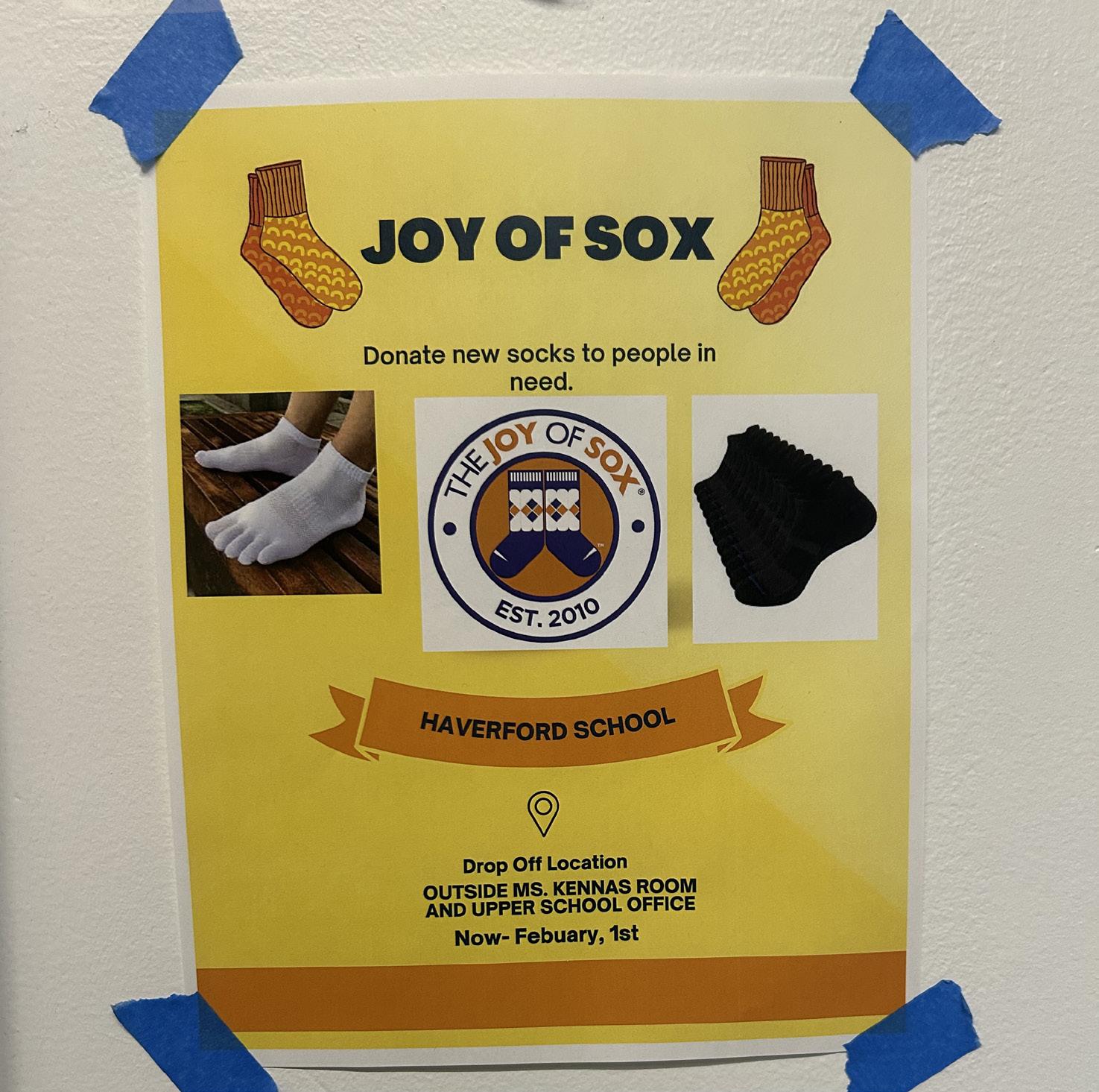
Milan Varma ’25
History is as much about forgetting as it is about remembering. History teacher Mr. Kevin Tryon spoke a version of these words to his European Dictators class this year. Those words could not ring more true when it comes to the discussion of the historical figure and civil rights activist Dr. Martin Luther King, Jr.
On Thursday, February 5th, the history department’s Parker Lecture featured a visit from New York University’s Silver Professor of Social and Cultural Analysis and History Dr. Thomas J. Sugrue.
Educated at Columbia, Cambridge, and Harvard, Dr. Sugrue is a twentieth-century U.S. historian of American cities and suburbs, race, civil rights, politics, and public policy. Dr. Sugrue is past president of the Urban History Association and the Social Science History Association and a fellow of the American Academy of Arts and Sciences, the American Academy of Political and Social Science, the Royal Historical Society, the New York Institute of the Humanities, and the Society of American Historians.
In his Parker Lecture speech, Dr. Sugrue addressed the misconceptions surrounding Dr. King. Dr. Sugrue honed in on various aspects of Dr. King’s character and how they are often singled out in his public perceptions.
For example, MLK Day, a holiday celebrated nationwide, emphasizes the need for service. However, Dr. King cannot be simply summed up as an advocate for service and civil rights. His philosophy and background were much deeper and more varied than these surface-level perceptions.
According to a Stanford study cited by Dr. Sugrue, Dr. King is the most wellknown American historical figure to youth in America. This popular knowledge of Dr. King shaped Dr. Sugrue’s speech by giving every student in the Haverford audience a foundation to build on when it comes to learning about Dr. King and the civil rights movement.
“I thought he gave insight into a topic that I obviously knew about, but as he said in his speech, not to the depth at which he covered it—very surface level,” Fifth Former Jack Ford said. “I was able to learn a lot more about Martin Luther King and who he was as a person.”

The topic and method of delivery vary in how they were received by the student body. With attention spans lower than ever, according to a recent Google report, some may find lecturing as a way of learning outdated.
“I think it’s nice to have prominent historians come and talk to us. I know Eric Foner spoke here a few years ago, and he wrote our American history textbook,” Ford says. “I think with the community, it goes over two ways. I think the kids who are motivated and interested in history find it to be engaging and informative. I think other kids find it to be a very nice nap time, and I think it’s hard to bridge that gap. I think Dr. Sugrue did a great job trying to engage everybody.”
Sixth Former Matthew Yerger attended lunch with Dr. Sugrue following his lecture.
“I think it’s very appropriate given it’s Black History Month to highlight MLK. I appreciated the light he shed on Dr. King’s economic policies and other overlooked qualities that he had,” Yerger said.
Expanding on his experience with the post-lecture lunch, Yerger said, “The connection to the DEI movement was probably the most interesting thing to me, so I appreciated all the questions about that. For example, comparing the movement to the recent George Floyd protests.”
This topic can not be more timely as a recent executive order by President Donald J. Trump focused on this exact idea of DEI - diversity, equity, and inclusion. The order “terminates ‘diversity, equity, and inclusion’ (DEI) discrimination in the federal workforce, and in federal contracting and spending.”
Dr. Sugrue expanded on the convergence between modern DEI, the civil rights movement, and our current positioning with racial equality.
“The idea of a perfect union means imagining something that we don’t have or we’re pretty far away from, but really ideally, if we truly lived in a society where racial distinctions didn’t matter, then we would see pretty common influence across people
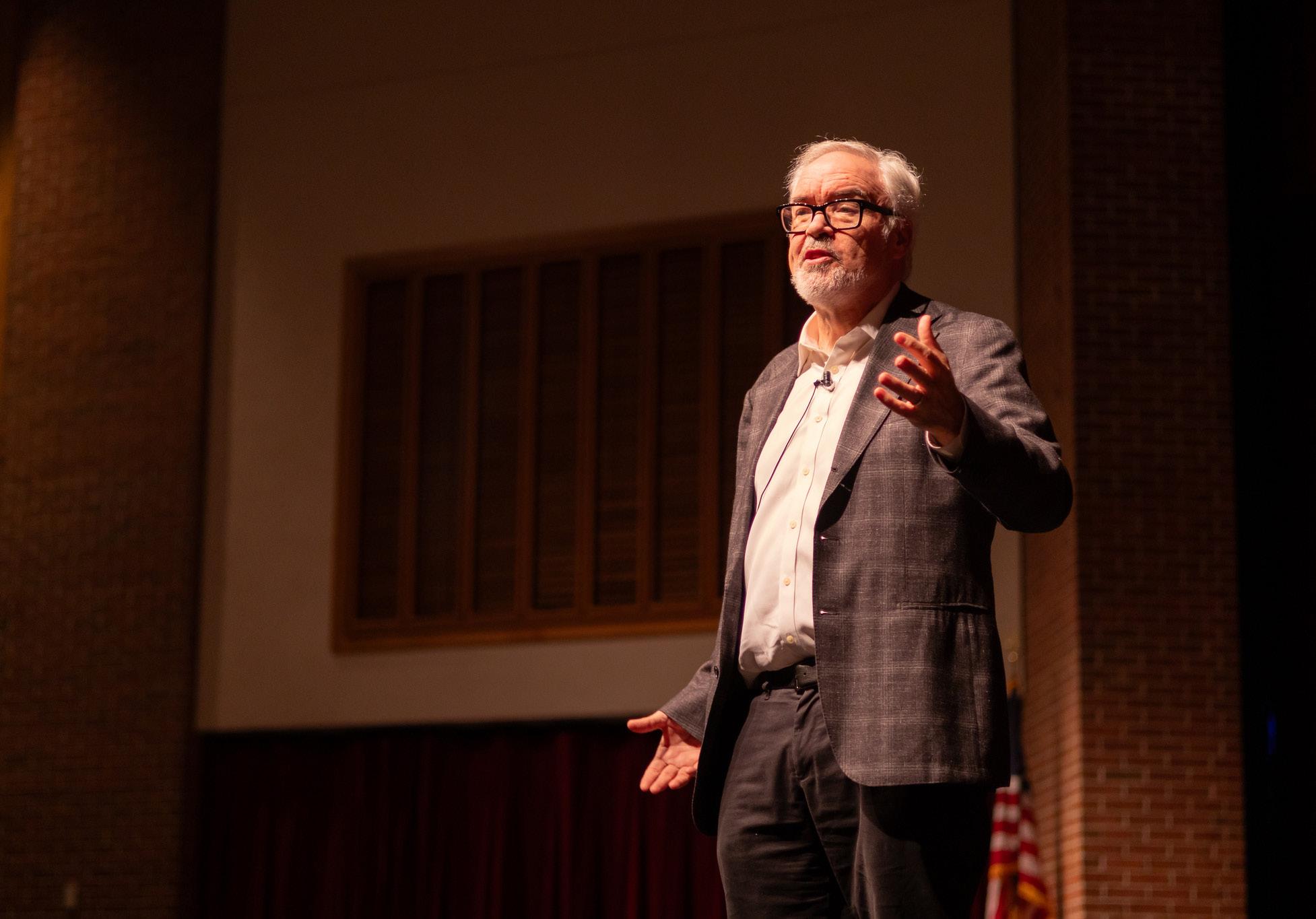
racial and ethnic backgrounds,” Dr. Sugrue said.
“So we would see people living and they create different housing and markets where they’re wanted to live in society where it was more or less equality, there are differences between the individuals, yes, but the difference between the individuals don’t sum up the differences between groups of individuals based on their inherent personal or physical or behavioral characteristics. I mean there’s a lot of research going back decades. It depends on where you’re situated in the larger social order, and that’s why we’ve come a long way. They were hard-fought, but we still have a long way to go to get to what I would see as following that [MLK’s] dream.”
“He would be working really hard to try to break down the distrust between different groups. In other words, to use the language of today, to be an economic populace but bring everyone together over some common goals.”
DR. THOMAS SUGRUE
Dr. Sugrue closed his time at Haverford with some words about Dr. King’s beliefs and how they would apply to today’s world.
“Central to King’s vision from his Social Gospel training as a theology student up to the people’s movement in 1968 was the idea that we should build a broad coalition of people who are having insecure lives, don’t have access to good housing with schools, who are discriminated against in employment, don’t have access to good jobs, and we should bring them all together,” Dr. Sugrue said. “What would happen if he’d been alive? He would be working really hard to try to break down the distrust between different groups. In other words, to use the language of today, to be an economic populist but bring everyone together over some common goals.”
Keith DiMarino ’27
The Fords against Malvern— Haverford’s most prominent rival—in a basketball game that draws vast sums of students, around 350 of them, from both schools each in their sections, roaring as loud as they can to help aid their team to victory, as each player uses every muscle and burns every calorie to carry their school to victory.
The Fords scream as K.J. Carson drains a three from downtown, pushing their lead in an inevitable victory against The Malvern Friars; the same Friars that had stormed the Fords’ home court after a slim 48-46 victory on January 14.
Let’s rewind to get a full grasp of how we arrived here. When finding a spot to pick where to look at the start of the HaverfordMalvern rivalry, you would track to the founding of the Inter-Ac, but for time’s sake we will start where Sixth Former and Student Body President Josh Williams said, “Students started to throw gas on the fire…”
In the frigid fall weather during the end of a whiteout football game on the Friars’ campus, the Fords lost a brutal 27-0 football game—but some like to argue the Fords actually won.
“While we lost the game, we won the student section,” Fourth Former Lucas Crutchlow said.
Allegedly, as the game rounded down the final minutes, The Friars just got up and left. “When you’re winning a game you would assume you would stay to watch the whole game, right?” Crutchlow said. “Instead, they just got up and went home right around the middle of the fourth quarter.”
After the game, the Fords ran out of the bleachers hand in hand in their white outfits. Halfway through the run to the parking lot, they came across some 40-60 Malvern students.
Crutchlow said, “We were eight feet from each other, exchanging remarks and getting closer until Coach Murphy got in the middle before anything could happen and dispersed us.”
The second major event occurred at McBride Court.
Two days before the game, student leaders from Haverford and Malvern met at the
field house. Dean of Students Mr. Luqman Kolade, Head of Upper School Mr. Mark Fifer, Athletic Director Mr. Michael Murphy, the Malvern Athletic Director, and the Malvern Head of School also attended.
“We had a conversation about our rivalry, what’s going on, why tensions are high, our conduct moving forward, and what that should look like,” Williams said. “After a talk like that, especially with their AD being there, I was thinking, well, this game should go smoother than any other one.”
Feeling confident, Williams attended the game with high hopes of not just a Fords win, but also a supervised and civil viewing experience.
Just after Malvern won 48-46 in overtime, Malvern fans stormed the court, specifically the logo of the Fords—the H.
“When I’m walking out the door, I hear all this commotion and then I look back and I see a thousand Malvern kids on our H,” Williams said. “No way they come to our house before the game and say, ‘Hey, this is how we should act moving forward,’ and then just disrespect not only the conversation we had but our whole school student
body and administration.”
At least two Malvern students slapped the H, and many others danced on this symbol of Haverford.
The next day, a Signet Society meeting discussed the Malvern Rivalry and how Haverford will continue with it.
“We had a 40-minute conversation about The Malvern School, what they just did, what that means for the two schools, and how we’re moving forward,” Williams said. “I don’t know if they’re just blowing us off or they don’t care, but it seems like our efforts to try to reach out to them for them to apologize to us—or maybe just, do something—is in vain.”
This escalated conflicts to a whole different level, intensifying as Haverford prepared to play against their rivals in a Tuesday night game at Malvern.
Williams said he spoke to both Mr. Fifer and Mr. Kolade on multiple occasions to talk about how the game could go and how the student section might react.
The Fords went on to win the game, 60-35, and fans ran into the parking lot to celebrate. According to Mr. Kolade, Coach
Murphy, and Mr. Fifer, a large gathering of Fords cursed at Malvern and their behavior posed a risk of turning into a conflict. This led to the inevitable punishment of taking away the student section at the February 7 home game against Germantown Academy.
Fifth Form basketball player Emmanuel Butts said, “Not having a student section today definitely impacted our energy and the tempo.”
Williams is curious about the scheduled Friday night lacrosse game with Malvern.
“The two powerhouses of not only the Inter-Ac, but the country… The student section would be electric, Williams said. “I know they were in talks of it—depending on how conduct goes with Malvern—if that the game is viable or not.”
With the winter season drawing to a close, the cold weather leaves us with more questions than answers. Will the Fords be able to play Malvern in the spring? What will happen if the Fords step out of line again? How will the Fords be able to respond by taking the higher road? These are all questions to be answered as the warmer weather rolls around.
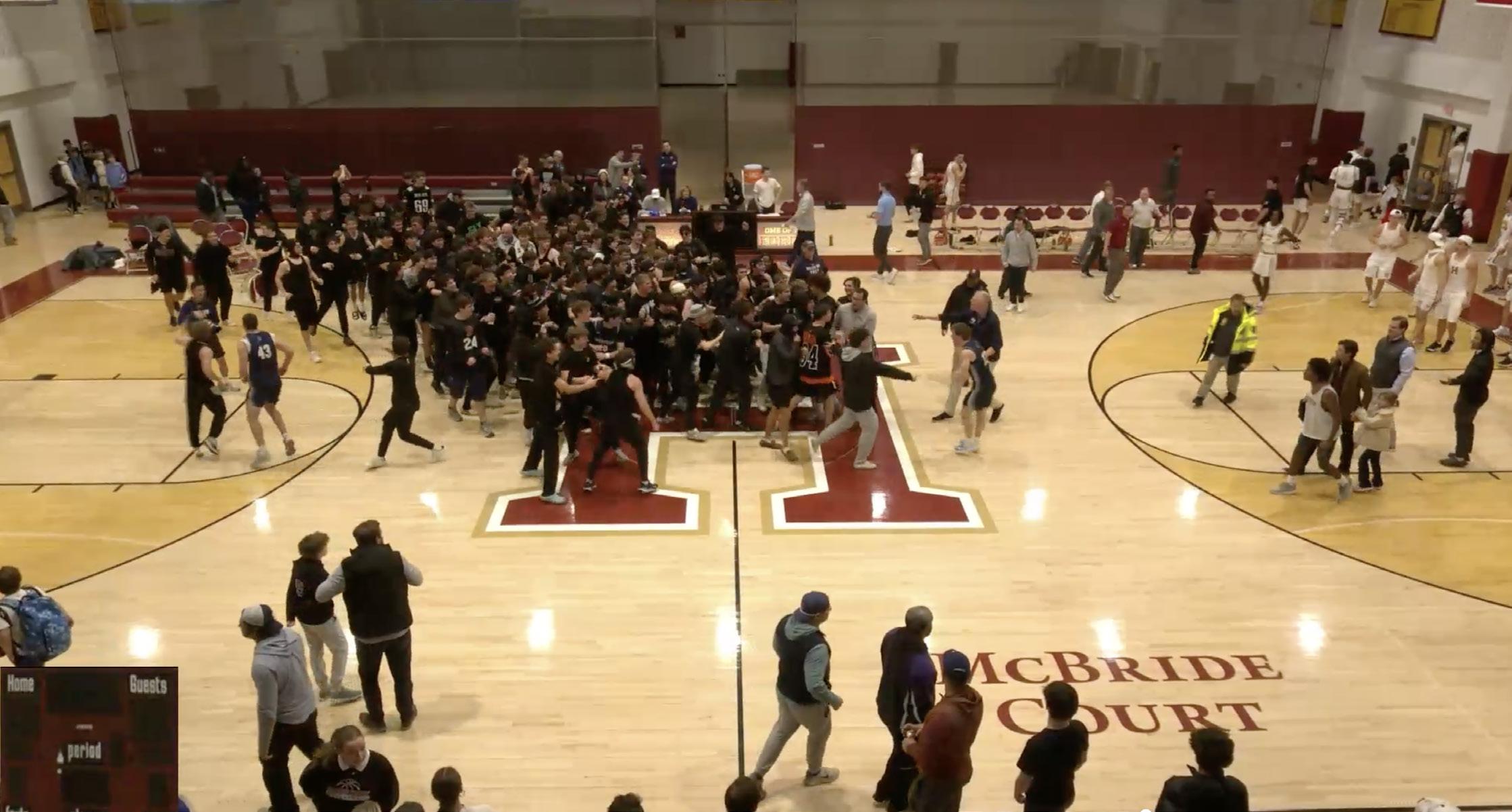
Former U.S. president Jimmy Carter passed away at age 100 in his home on December 29, 2024, after being in hospice care for nearly two years.
Carter served as the 39th US President from 1977-1981 right after the nationwide Watergate scandal. Carter promised to bring decency to the White House and be a president the people can trust. After narrowly
defeating Gerald Ford, Carter won the presidency.
However, his presidency was challenged by several factors outside of his control, including the economy, inflation, and wages.
While Carter did have several notable accomplishments, such as the Camp David Accords, confrontation of “stagflation,” and pardoning all Vietnam draft dodgers, he was
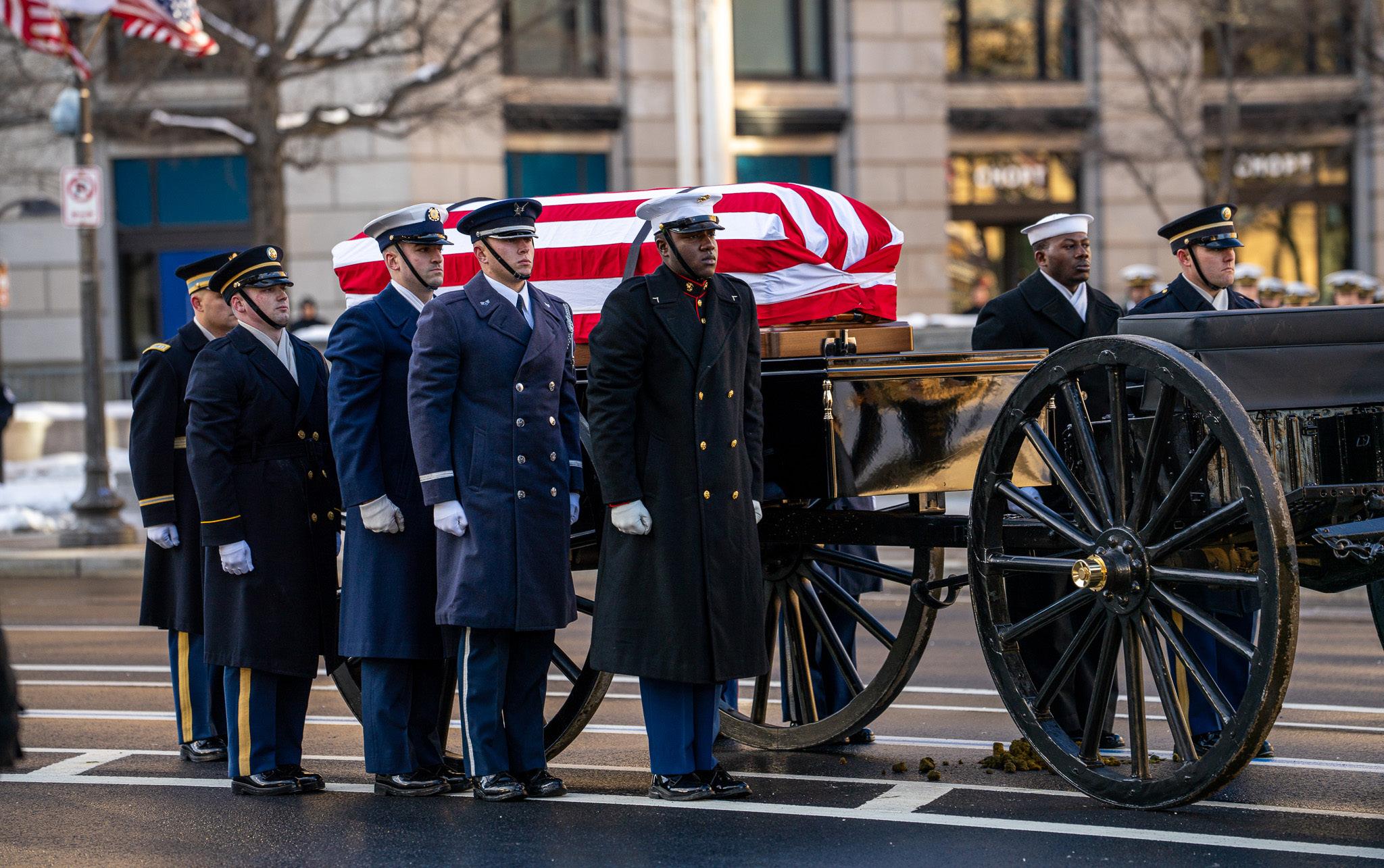
ultimately defeated by Republican challenger Ronald Reagan in the landslide election of 1980. Yet this did not stop Carter, and his defeat only seemed to mark the beginning of the longest post-presidency term to date (nearly 44 years).
During that time, Carter was able to build The Carter Center, which promotes peace, health, and human rights as well as Habitat for Humanity, a Christian organization that builds homes for the unfortunate.
Carter continued to work with these organizations well into his mid-90s and enjoyed high favoribility ratings during his post-presidential years. When Carter passed away on December 29th, many people mourned the ex-president who had done so much for his community and nation.
All former U.S. Presidents put out a statement sending condolences to his family and all flags were set at half mast for 30 days.
Carter’s death had a sizable impact on both students and faculty.
According to science teacher Mr. Andrew Grossman, “Death becomes this amazing reminder of what somebody did and who they were,” Mr. Grossman said. “[President Carter’s] post-presidency has been one where he really dedicated his life to service in a way that few people of that level of privilege felt
the need to. I think he was an unpopular president, but he was humble, hardworking and somebody who cared about improving the lives of people around the country. Even though I was sad to see him go, he lived a long life, and the message of his life is very clear.”
Economics and computer science teacher Mr. Stuart Alden, who participated in both the 1976 election and 1980 election, directly experienced the period himself.
“I did not vote for Jimmy Carter although I thought he was a thoughtful and intelligent president,” Mr. Alden explained. “I think that he was effective in many areas. I appreciate his concern for people and contribution after he left the presidency including all the work he did with Habit of Humanity.”
Fourth Former Eli Dixon said, “I’m sad to hear of his passing. I know he was a good man, he helped build houses. I thought The Carter Center was cool,” Dixon said.
“I think he was probably the best president from a moral standpoint,” Fifth Former Desmond Henecks said. “Even though he was not great during the time he was president, he did a lot of good afterward. I think [his passing] was sad but he was hanging on by a thread so it wasn’t unexpected.”
It is six months into the school year, and the Student Council is chugging along. Each form has its own goals for the year and has completed several projects.
Third Form President Chris Li shared a goal that all student council presidents had in common. “We want to help the school,” Li said.
He then moved on to their second goal, which is to make opportunities for the grade to do service. He organized a project where the grade helped clean up a preserve.
Fourth Form President Ray Kresge said, “A big goal is strengthening connections within the class, as sophomore year is crucial for relationships. We’ve had several activities to foster these connections, and we think it has been a success.”
The Fourth Form student council is also currently running a sock drive. Krege also aspires to set up a Dollar Dog Day, potentially for the season-opening game of the Phillies.
Fifth Form President Ryan Shams’ goals are different from those of other grades.
“Our first goal is to gather the class’s opinion through a monthly opinion poll,” he explained. “Our second is to inform the grade on possible careers through career sessions. The third goal is to have fun community bonding sessions (e.g., trivia competi-
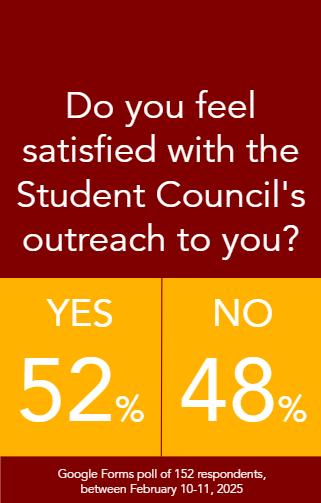
tions). And the fourth goal is to inform the grade on elective courses for next year.”
Shams has organized three career sessions so far: one for finance, one for law, and one for business.
“We [also] hope to do one on engineering,” Shams said.
In addition to these career sessions, the Fifth Form leaders also planned and executed a holiday fundraiser where they sold candy.
Sixth Form President Josh Williams’ goal may be simpler than the Fifth Form’s, but it is just as challenging.
“Broadly, we aim to connect not only students but also faculty. We are that bridge, facilitating that connection. We want students to feel comfortable coming to us with their problems. My main goal was brotherhood—having everyone talking,” Williams stated. “One of our other goals is a service project from each grade,” he continued, “and a gift from the seniors to the school.”
He then turned to what he had accomplished so far. “I planned homecoming. I don’t get to plan prom, unfortunately. Homecoming was very successful. We made $3000 and gave $1500 to charity.”
However, Williams’ priority is to guide the younger leaders.
“Everything comes through me. If one of the student councils needs something, they come to me. Guiding the younger council’s ideas for halftime events at basketball games is tough, and we get blocked quite a lot. The Sixth Form Student Council’s goal is to guide them through that and make sure they keep going.”
One of the issues that has faced the student council this year is feedback.
“So far it has been pretty good. People have been talking to me if they need something,” Li said.
The Fourth Formers have mainly been communicating in person.
“Mainly mouth-to-mouth feedback. I think that a big thing that we have done well is talk to everyone,” Kresge said. “It’s really the conversation that builds the connection.”
“I definitely need more feedback though,” Kresge added. “I’m excited that the student council has an email chain. We are going to be creating a form for the sophomores to gather feedback.”
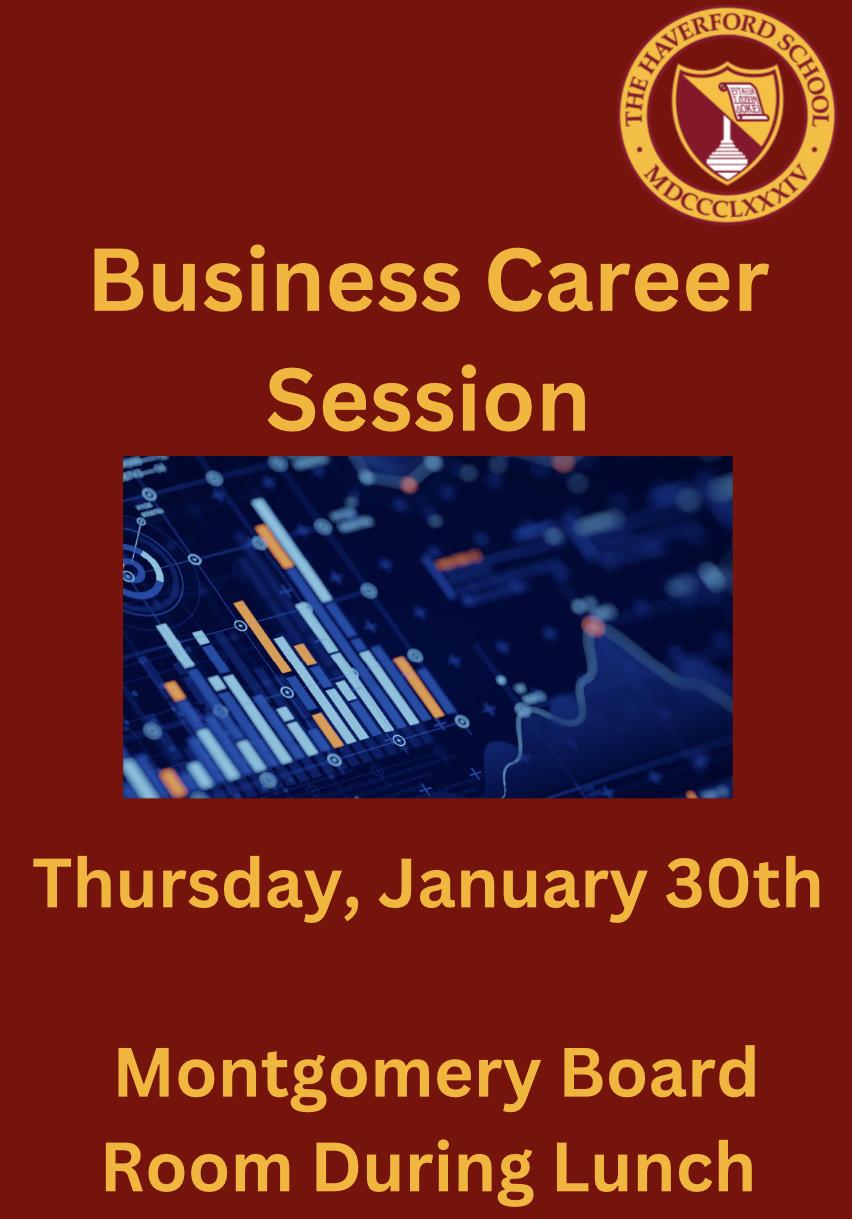
Shams is already conducting these polls with the Fifth Form. “The Google forms have had good response rates. We have a good sample size as well. The most recent career session also had good attendance. In addition, people are engaged in the form competitions,” he explained. “I would like a few more responses though.”
Williams is having the most problems with the senior class. He uses a grade group chat as well as polls. “I don’t think that it is effective,” Williams said. “I 100% need more feedback. Whenever there is a poll of seniors, we can see responses, we would get only 20 responses out of 120. Half of these are jokes. I definitely need more feedback. The only guy really giving feedback is Mr. Kolade.”
Williams provided this example. “AIS wanted to do something. I sent a message to the grade group chat. One response and one joke are all that I got. How can I gauge that?”
Williams asked.
“It’s hard to get people to do something. There always needs to be an incentive,” Williams said. “People take our work for granted. We meet almost every week individually and biweekly as a huge group. People do not see that. Lots of things get shot down. It’s hard because a bunch of ideas get shot down, so what we do is sometimes not as amazing.”
Williams is planning a few more activities. “We might play bingo. We also want everyone to go to upcoming games. We also might do something new. The reward for this might be a day of immunity for Senior Assassin,” Williams said.
“We really need to lean into the community at this time of the year. It’s winter. Strengthen our brotherhood. We are in the thick of it and everybody knows,” Kresge said. “By leaning in we can take off the pressure.”
Social media is omnipresent in our everyday lives. Whether it be posts from a friend or celebrity, a new song from a favorite artist, or funny videos circulating, media is an influential topic. And one platform that is highly debated is TikTok, one of the world’s most popular social media platforms ever, connecting content creators and audiences through recommendation algorithms.
TikTok is an active platform, presenting over one billion global active users each month. Demographics range from teenagers to adults, singular content creators to global businesses, and people of different nationalities, races, and ethnicities.
However, TikTok’s presence is highly debated politically. Politicians scrutinize TikTok for its possible violations of data privacy and false information, and now, its presence on devices is threatened.
On January 18, TikTok was banned as a part of an act by Congress banning apps that could be potentially “harmful” to the U.S.
government. Shortly after, President Donald Trump postponed the ban for 75 days. Still, a question remains: how will this affect the nation’s population, especially teenagers and students?
The number of teenagers who use TikTok is staggering. As reported by the Pew Research Center in 2023, the percentage of teen users that use TikTok is a high 63%. 58% of teens use TikTok daily. But is the output positive or negative?
Like most social media, TikTok possesses a recommendation algorithm based on the videos that you watch and interact with, which can be helpful if you want to ingest new knowledge and watch funny videos. It can also be harmful, however, as videos can sometimes contain depressing and potentially harmful content, or provide false information.
Exposure to these short-form videos can highly affect a person’s view of their surroundings and their self-image. Additionally, another topic arises —
data privacy. TikTok mainly came under scrutiny for how they handled sensitive information of their users.
So what are students’ thoughts on TikTok, and how do they react to what they see?
Third Former Aidan Hinds thinks TikTok doesn’t affect his views much.
“I don’t really believe everything I see. It’s more something you joke on and have fun with. I don’t really see TikTok as something to be taken seriously,” Hinds said.
Hinds thinks a TikTok ban would “affect a lot of teenagers because it’s popular, everyone uses it. It’s addicting. You’re there for one second, and then you end up there for the rest of the night… If it doesn’t get banned, then I think it’s going to be more of an excuse for kids to be on their phone. If it does get banned, it teaches people how to focus better. I think TikTok should be used for right, not for wrong.”
On one hand, TikTok can be everything for a content creator. On the other hand, it can simply be an addicting viewing platform.
As a teacher and parent of a student who goes to Haverford, Latin teacher Dr. Andrew Fenton finds that TikTok isn’t any more negative than other social media platforms.
“I think that it is very easy to waste a lot of time on social media. I don’t think that’s exclusive to TikTok,” Dr. Fenton said.
Referencing Preston Swei’s reflection, Dr. Fenton stated that other platforms can be “at least as deleterious as TikTok would be.”
“I don’t see any reason to ban it in priority of digital use of social media. If I had the ability to snap my fingers and make all social media disappear, I would do that. [If it were banned] Haverford boys would find some other way to kill time on the internet, whether Snapchat or something else,” Dr. Fenton said.
For now, TikTok’s stance in the online world now depends on the very people who use and consume it.
Over the years Mr. Tryon has also taught Ancient World History and the honors-level European Dictators class, a Sixth Form course.
When asked what he enjoys about teaching history, Mr. Tryon says he likes the narrative.
“[History] is the study of all of us, the story we all share. It is curiosity about each other, our past, where we came from and, possibly, where we are going. We are all storytellers and the narrative of how [events] unfolded is interesting,” Mr. Tryon said.
Mr. Tryon’s favorite part of teaching here is the ability to teach different grade levels.
“Teaching seniors at the honors level is
a world away from teaching ninth graders,” Mr. Tryon said. “It’s fun to get to see the cerebral development of boys over four years.”
“Teaching I do in long pants and coaching I do in short pants.”
MR. KEVIN TRYON
Mr. Tryon humorously compares himself and his role to that of Gandalf from Lord of the Rings, with students being the hobbits he has to protect. He is similarly funny
and reflective when considering his role as a teacher and a coach, noting they are very similar.
“Teaching I do in long pants and coaching I do in short pants,” Mr. Tryon said.
In addition to coaching junior varsity soccer at Haverford, Mr. Tryon is involved as a coach with the Eastern Pennsylvania Youth Soccer Association, where he was recently recognized with the Mike Barr award.
The award is presented to an individual who has demonstrated a lifetime of dedication to coaching and educating within the Eastern Pennsylvania youth soccer community.
According to the award criteria, recipients are those who have “served with integ-
rity, honor, humor and humility and have made extensive and far reaching contributions to the process by which youth soccer players and coaches are taught in Eastern Pennsylvania.”
These are the same characteristics Mr. Tryon brings to his classes, where his integrity, honor, humor, and humility also shine through.
“My high school experience wouldn’t be the same without Mr. Tryon,” Sixth Former Kevin Covington said. “As an advisor and teacher, he has guided me, supported me and encouraged me to be the best I could be.”
Brandyn Luong ’27
The Signet Society contains individuals with often overlooked personalities. This group of fifteen Sixth Formers, elected by their peers, embodies the school’s values and plays a vital role in shaping leadership. By fostering leadership skills, its members strengthen the connections between students across all grades. Their events and engagement with school leaders have a significant influence on the school’s culture.
Let’s take a look at Sixth Former Mason Wiegand’s journey to joining Signet Society and its impact on his life here.
Wiegand first learned about Signet Society at the end of his junior year, initially only knowing that it represented the school. As a member, he has attended meetings with Form Dean Mr. Will Leech, taking on numerous tasks important for the community such as handling Sixth Form parking. He has met with many school leaders, such as the Head of School Mr. Casertano, to address larger issues, including difficulties in managing the students at high-stakes sporting events. Among these were the most recent Malvern-Haverford basketball games, which have caused agitation in the community recently.
Reflecting on the group’s role in the community, Wiegand emphasized its diversity. “The Signet Society is made up of a diverse group of people because anyone can be a part of it. It’s there for anyone who opens themselves up to it,” he explained.
However, Wiegand’s leadership journey was gradual. He tried out for various leadership roles in his Third and Fourth Form years but did not find much success. This changed when he applied to the Character Mentorship Program (CMP) as a Fifth Former and was accepted. He now serves as the Chairman this school year.
CMP is a student-led system composed of five Sixth Formers, five Fifth Formers, and two faculty members. CMP members are assigned students found in violation of the Honor Code to help guide them and prevent them from making future mistakes.
“Leadership isn’t about your status It’s about your impact.”
MASON WIEGAND ’25
Wiegand’s
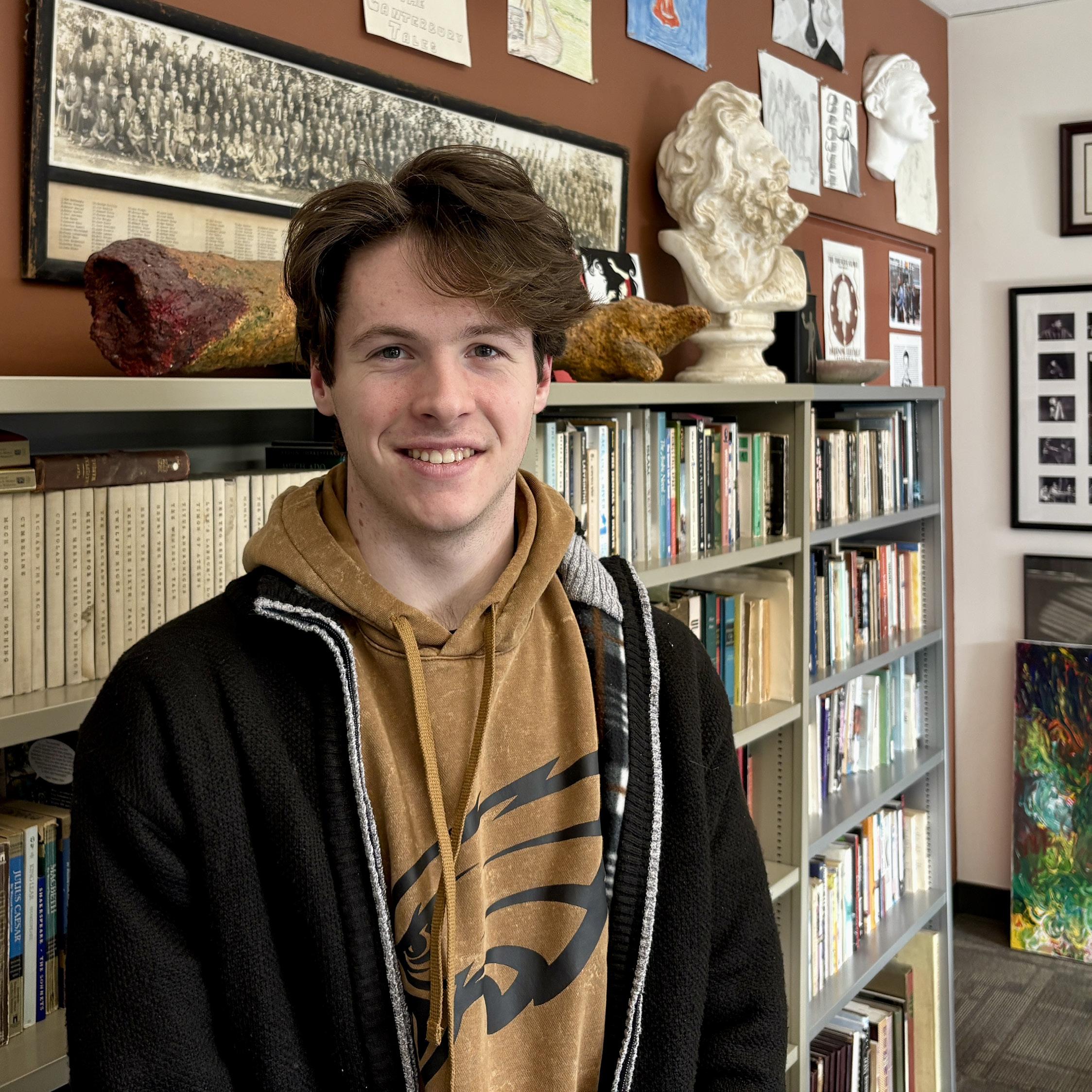
Mason Wiegand ’25
his highly reflective work with many different students. “There hasn’t been a defining moment for me in the CMP. Rather, a series of people and experiences have radically changed how I see myself and Haverford,” Wiegand said. “Each person is dealing with the same few core issues of identity: Who am I? Where do I belong?”
He credits his growth as a CMP member to the students he has mentored in the program. “By taking the time to look at myself objectively, I’ve found more enjoyment in Haverford, and I hope I have shown that
to the students who I’ve mentored as well, Wiegand said, “They were the ones who taught me.”
A defining moment in Wiegand’s journey came at Camp Saginaw, where he bonded with the current Third Form and helped them prepare to adjust to high school life.
“I realized how important it is to make younger students feel comfortable. I remember sitting around the campfire, talking with freshmen who were nervous about high school. Just being there for them made a difference,” Wiegand said. “That’s when I knew
leadership isn’t about your status. It’s about your impact.”
For Wiegand, leadership has been about being open-minded, being mature, and embracing every opportunity.
Outside of school, Wiegand serves as the Outreach Director for the Global Compromise Collective, a nonprofit focused on diplomacy and combating polarization. Wiegand demonstrates that being a leader isn’t about your titles and accomplishments; it’s about leading by example and making positive impacts.
Friendly, humble, down-to-earth, dependable, chill—all these descriptions are only a few of the many admirable qualities of Sixth Former Phineas Manogue. Anybody unfamiliar with him would likely assume from his confident and composed demeanor that he had been attending Haverford since Pre-K; however, Manogue’s journey through Haverford began when he entered the upper school as a Third Former.
“So many things I would never have done if I didn't go to Haverford.”
Manogue’s first year at Haverford was a period of exploration and discovery, as he spent time trying his hand at a number of different activities, whether they were new sports or clubs.
“Freshman year, I was trying to figure out what I wanted to do, so I went to a couple of clubs,” Manogue said. “I did math club and I was going to do entrepreneurship club but then I decided a couple months in to start Certamen.”
Manogue said, “I knew I wanted to do tennis all four years but I needed to find another activity for my second sports credit, so I just did crew to condition [myself].”

The following year, rather than doing crew, Manogue pursued speech and debate. Then the year after that, Manogue joined the robotics team.
“I really liked Mr. Leech, I liked all the guys there, and I wanted to do it freshman year, but I was afraid that I wasn’t as experienced as everybody else,” Manogue said. “I kind of deprived myself of the first two years and I wanted to try something different.”
Now, as a Sixth Former, Manogue has found his place at Haverford as a pillar of its community as a member of the Signet Society.
“I think it’s one of the coolest things that Haverford offers, and I think that Signet is sort of like the bridge between the faculty and the students,” he said. “We’re the voice of the students, but we’re also carrying out the desires of the faculty and letting students
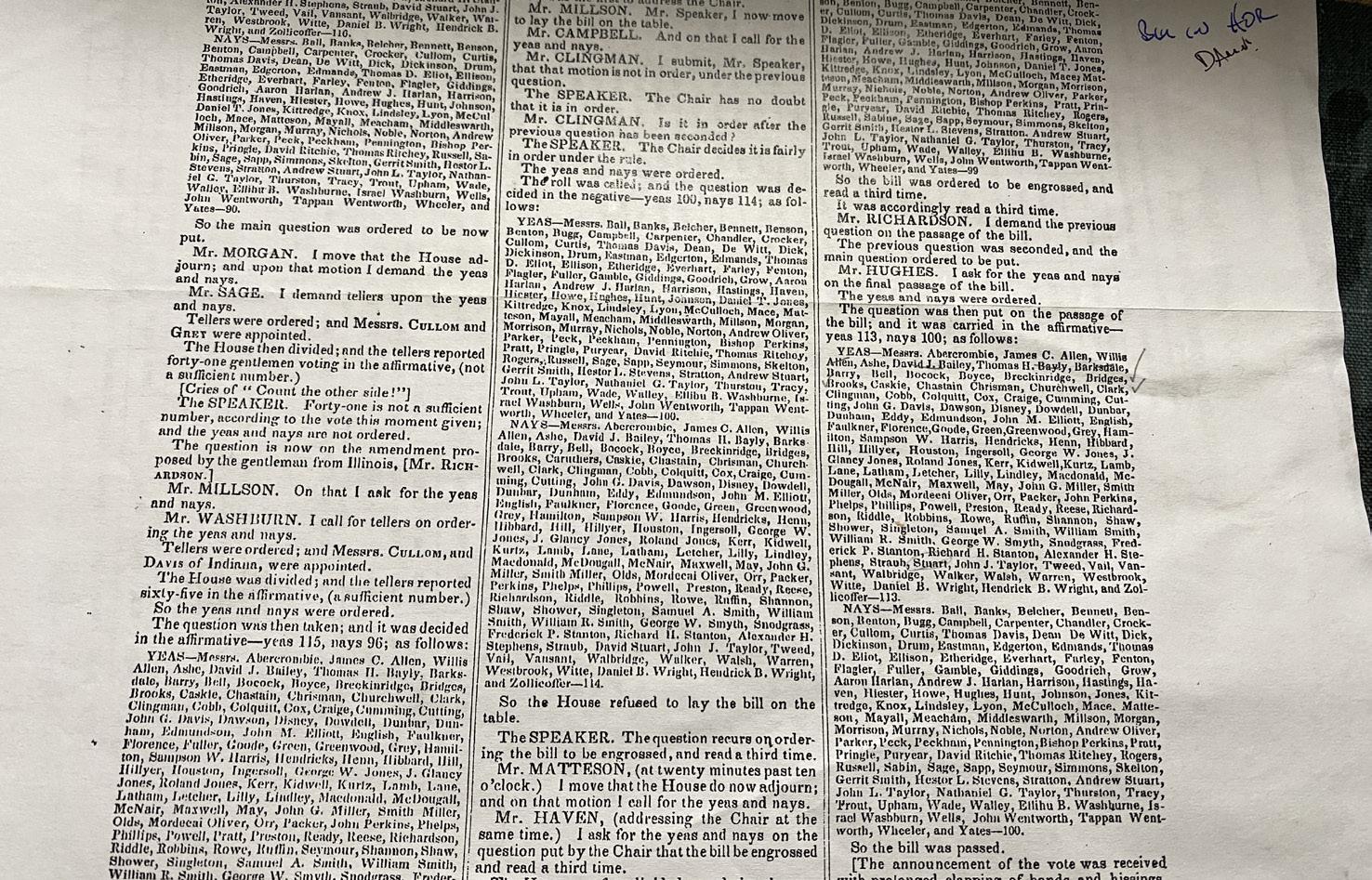
Over the past few years, U.S. History teacher Mr. Timothy Lengel has been working on and off on a research project.
“It started when Ms. Turlish and I were talking about the 3/5th compromise,” Mr. Lengel said. “We had both noticed that most students did not really understand how impactful it was.”
The 3/5th Compromise, which was passed during the Constitutional Convention in 1787, established that three out of every five enslaved Black people would be counted when determining a state’s total population. This allowed Southern states to significantly increase their population count due to the large amounts of enslaved black people, while still denying them their basic human rights. Significantly, the state population determines the number of representatives each state has in the House of Representatives, which is responsible for voting on
bills in Congress.
The 3/5th Compromise allowed Southern states to greatly inflate their census population, thereby giving them more votes in the House of Representatives. This increase in representation benefited the South in their push to maintain slavery.
“I wanted to look at a complete and organized dataset regarding the impacts of the 3/5th Compromise, but could not find one anywhere,” Mr. Lengel said. “I decided to create it myself.”
Mr. Lengel collected census data for each state from 1790 to 1860 from primary sources and organized it in a Google spreadsheet. This information included the free and enslaved population of each state. From there, he calculated the population gain for Southern states by multiplying the enslaved population by 3/5.
Next, he simulated a scenario of a 0/5th compromise, where black people would not
know expectations. I think it’s really important, and I’m so glad I’m a part of it.”
Another part of Manogue’s integral contribution to the Haverford community is his presence at sporting events.
“My favorite memories from Haverford come from this year: all the games I went to, which I didn’t go to in my first two years,” he said. “I really regret and wish I had gone to more games because they’re so fun. It’s really cool to see all the different people from Haverford all there and all supporting the same thing.”
Reflecting on his time at Haverford, Manogue said, “Haverford’s awesome. So many things I would never have done if I didn’t go to Haverford.”
Manogue said, “The sports credits [requirement] made me do speech and debate. I’m terrified of public speaking—it’s prob-
ably my least favorite thing. I can barely talk in front of my own extended family if all the attention is on me, so the fact that I did [speech and debate] is one of the most insane things I’ve ever done.”
Summing up his upper school experience, Manogue advised, “High school is not supposed to be a time where things are set in stone. [Everyone] should try as many new activities and go to as many different events as they can.”
Outside of Haverford, Manogue is an extremely capable sailor, having won the club championship for the club he sails at. His attitude of consistently trying things is exemplary, and he will continue to explore and discover at the prestigious University of Chicago, where he plans to major in mathematics and chemistry.
count toward the state population. He recalculated the number of representatives each state would have. As expected, the Southern states lost power. “The future Confederate states gained 5-6% more power in the House of Representatives due to the 3/5th compromise,” Mr. Lengel said.
Then, Mr. Lengel applied the recalculated makeup of the House of Representatives to the voting on the Kansas-Nebraska Act. The Kansas-Nebraska, which had narrowly passed in the House of Representatives in 1854 by a 113-100 vote, allowed the territories of Kansas and Nebraska to decide for themselves whether or not to allow slavery based on popular sovereignty. However, this act violated the Missouri Compromise of 1820, which prohibited slavery north of the latitude 36°30´; Kansas and Nebraska were both situated over that line. This act significantly heightened tensions between the North and the South in the 1860s and led to a series of violent conflicts, most notably “Bleeding Kansas.”
In Mr. Lengel’s simulation with the 0/5th compromise, the Kansas-Nebraska Act narrowly failed in a 106-107 vote due to fewer votes supporting the bill from Southern states.
“The Kansas-Nebraska Act was a major bill that drove tensions between the North and the South and led to the Civil War,” Mr. Lengel said. “A major question among historians is what would’ve happened if it didn’t pass.”
The simulation of a 0/5th compromise wasn’t perfect because no one can know where each vote would’ve fallen, but reasonable assumptions were made based on the political make up of and how polarized the United States was at the time. Southern states lost votes for the Kansas-Nebraska Act as almost all of those states had uniformly voted to pass the bill.
“That’s how all you reevaluate past events, you try to make reasonable assumptions in order to draw a conclusion,” Mr. Lengel said.
Mr. Lengel hopes to find some more time to work on this research project in the future once his newborn child is a little older. “I hope to simulate some other bills with the recalculated makeup of the House of Representatives, such as the Lecompton Constitution,” Mr. Lengel said. “The passing and failing of major bills were significant driving forces leading to the Civil War.”
He hopes to write an essay once his work is finished. “It’s nice to just write things out in an essay,” Mr. Lengel said. Mr. Lengel encourages students to investigate anything they’re interested in. “All the data is out there. You don’t need super advanced skills to do research,” Mr. Lengel said. “Ask others for help; Mr. Long, Mr. DiBello, and Mr. Leech helped me with the spreadsheet. Just give it a shot and take that first step.”
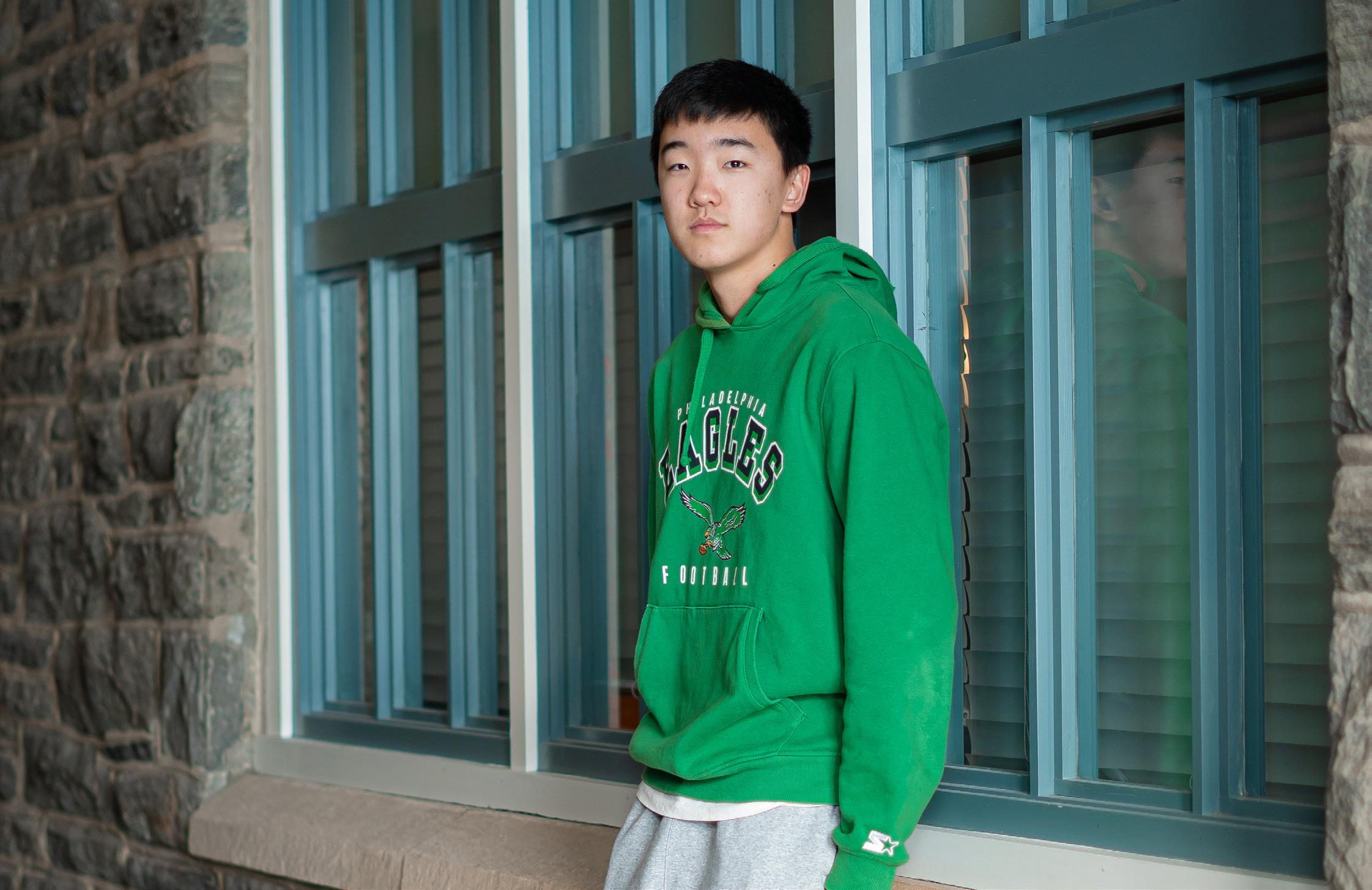
Meet Preston Swei, a Sixth Former, varsity soccer player, and Signet Society member. Swei transitioned to Haverford in sixth grade, and he immediately noticed the different atmosphere.
“The biggest difference between my school and The Haverford School would be the all-boys environment,” Swei said. “I feel it was a space where people are more vulnerable, which was something I was not familiar with.”
Furthermore, he was used to having around 30 people in each of his classes, but that number dropped to 20 at Haverford.
Although Swei had a shy personality, he was able to talk to and meet a lot of new people, allowing him to make friendships that have lasted for seven years.
“The community at Haverford is definitely one that brings you in,” Swei said, “which made it much easier for me to meet
others and be a part of the brotherhood here.”
Swei felt another big transition between the middle and upper school. “The upper school feels more like a unified collective student body compared to the middle school, where it was mostly just independent grades,” Swei said.
In his Fifth Form year, known as the most difficult year, Swei took U.S. History*—a course notorious as among the hardest classes. Among its challenges were reading quizzes at the start of every class. Swei made sure to always set out some time to review the night before class.
“I made a schedule on my phone to follow,” Swei said.
These time management skills ensured
Jayden Thomas ’27
“The best way to find yourself is to lose yourself in the service of others” – Mahatma Gandhi, Lawyer and Freedom Fighter.
Service before self is a motto that we all can integrate into our mindset at Haverford. It is a guiding principle that can lead all students, teachers, and parents to embrace the positive health and moral benefits that come with helping others. In today's trying times where conflicts and catastrophes are omnipresent, simple acts of kindness, advice, and charity not only nurture the Haverford community but can impact the wider public community.
Altruism is the selfless concern for the well-being of others and is the culmination of many Haverford virtues including compassion, support, and dependability. The Haverford service board presents activities and service opportunities that exemplify altruism for students undertaking activities through teamwork, communication, and initiative. These acts of service such as preparing PB&J and food packages for the hungry and homeless or donating clothes, toys, and blood can provide benefits not only for the receiver but also for the giver.
Providing an act of kindness or voluntary service has been proven to show physiological and mental health benefits. These benefits have been presented in a study by Yeung et. al. where they surveyed 1500 people on their participation in various types of vol-
untary services connected with their health outcomes. The researchers concluded that participation in general volunteer work significantly correlated with greater social interactions, life satisfaction, and a decrease in depressive symptoms. A prospective study by Sneed et. al. found that volunteers who provided at least 200 hours of service in a year were less likely to develop hypertension compared to those who were less active volunteers.
Whilst Haverford has no requirement for the number of hours students complete for service, it is still a core virtue and should be upheld by all of us. If every one of us can consider one small act of service each day, in a year our school would have collectively accrued about 160,000 hours of service.
Selfless service can take many forms, but it all starts with you taking that first step: signing up for service opportunities, digging out clothes you’ve outgrown, and encouraging your friends and family to join volunteering projects. Let us continue to uphold our Haverford virtues and put “Service before Self.”
If you or your friends would like to support the many service activities available at school please contact our Service Board director, Ms Jini Loos either in her office or via email: jloos@haverford.org.
that he was on top of his work.
“Time management played a huge role in my junior year because of the difficulty of the classes,” Swei said. “I made sure that I knew what had to be done and by when.”
Swei has maintained his good grades while playing on the varsity soccer team. “We lost seventeen seniors last season, and there was a big gap that we needed to fill,” Swei said.
Still, the team overcame the adversity and finished the season 8-1-1, beating EA to win the Inter-Ac title.
“Being a center back kind of forced me to be a leader” Swei admitted. “I didn’t really consider myself a leader before, especially with my shy demeanor, but I picked up the position.”
The soccer team won against EA during EA Day, securing the Sweater.
“Preston is incredibly coachable—he absorbs the small details and implements them to gain an edge and perform at his best. As a leader, he may not be the loudest voice on the field or in huddles, but he leads by example every day, both on and off the pitch,” Head Coach Mr. Keith Cappo said.
Being a part of the Signet Society has helped Swei improve himself and the people around him. It has helped him get accustomed to talking to people more freely. It represents the challenges, experiences, and lessons learned that have shaped him at his time at Haverford.
Reflecting on his time here, Swei encourages younger students to step out of their comfort zone and try new things.
“Something I wish I had heard when I was a freshman was that my time in the upper school is meant to have uncomfortable moments. I believe that the only way you can waste your time at Haverford is by staying in your comfort zone, not trying new things,” Swei said. “This would have not only gotten me more involved with the community, but also might have given me an interest in an area that I would have never previously predicted.”
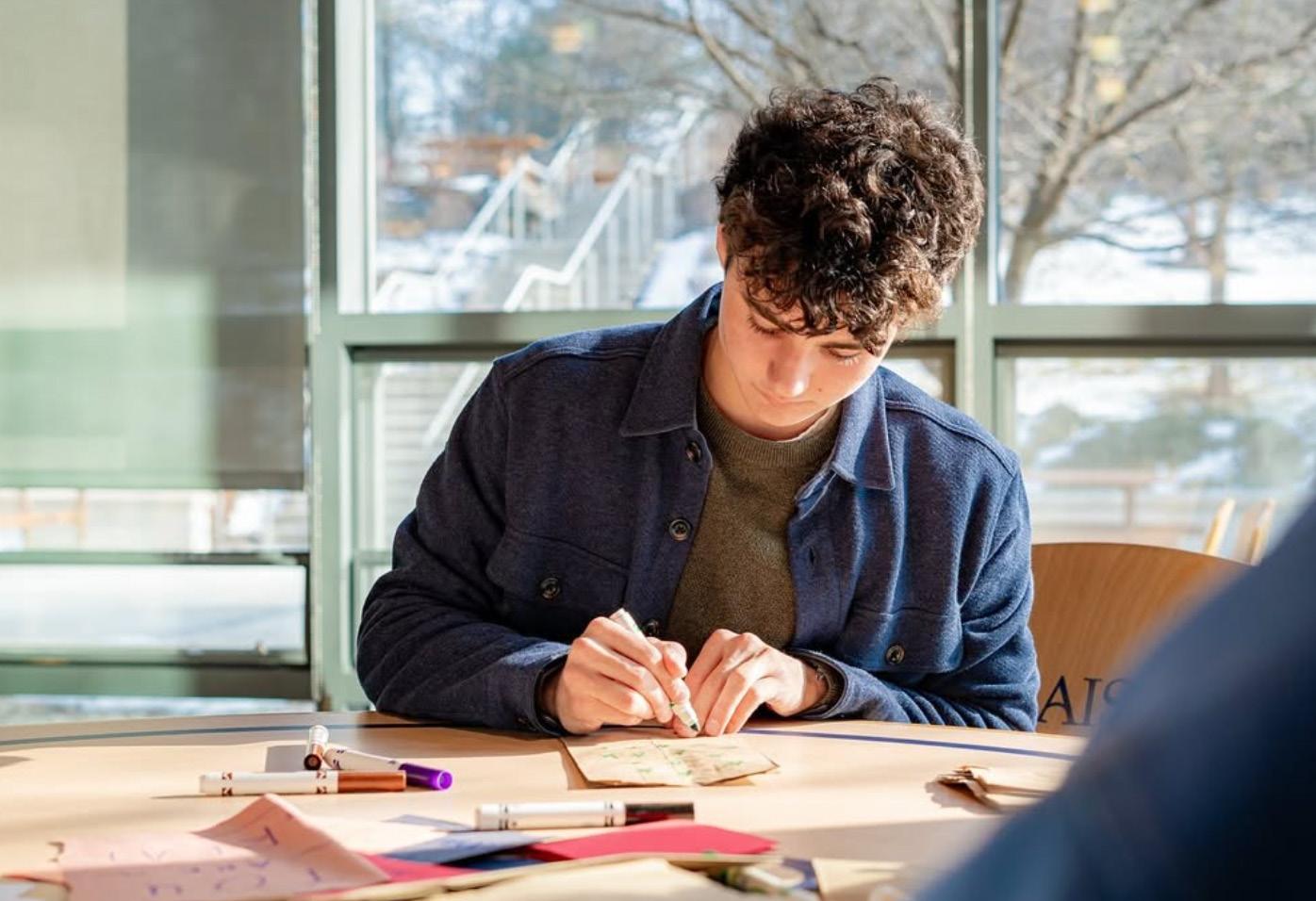

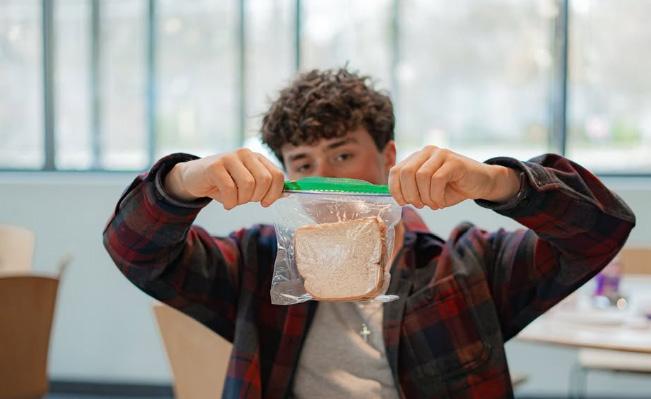
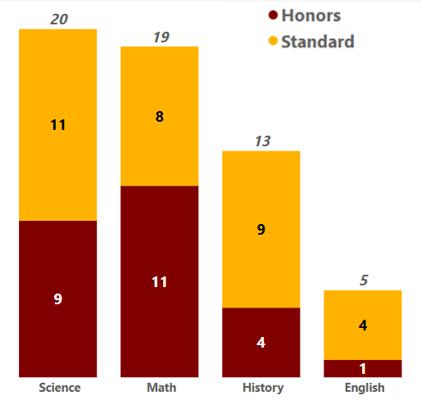
“The Haverford School is committed to preparing boys for life. Our college-preparatory educational program comprises academic, athletic, and community aspects that offers students both a broad exposure and grounding in several disciplines and the opportunity to pursue and develop more in-depth interests… The goal is to develop a course of study that: develops one’s talents and aptitudes through a varied curriculum, underscores talents, and strengthens areas of relative weakness.”
This is an excerpt from Haverford’s Upper School Course Catalog, describing the goals of the upper school curriculum. But does the upper school curriculum, specifically in science, math, English, and history really encourage students to underscore their talents and strengthen areas of weakness?
Or, do the course offerings, particularly at the honors level, when coupled with expectations of the college admissions process, create an environment where students seeking admission to competitive colleges are pushed into STEM classes at Haverford?
For the purposes of this article, “STEM” is defined as science and math classes. “Humanities” is defined as English and History classes.
Among other graduation requirements, Haverford students must complete 4 years (4.0 credit hours) of English, and 3 years (3.0 credit hours) each of history, science, and math. However, most students applying to competitive colleges will take four years of each of these “core” subjects.
For most students, the first two years of both STEM and humanities classes are prescribed. The only “choice” is in STEM classes, which start offering an honors level option in core classes in Third Form. There are no honors-level humanities core classes available until Fifth Form.
Haverford offers a total of 39 STEM courses and 18 humanities courses; these numbers include both core and elective courses.
There are some reasons the disparity in these numbers makes sense. In math, each “core” class (Algebra, Geometry, Precalculus) has a standard and honors level offering, which logically makes the total number of Math course offerings higher. This is also true for core science classes (Biology, Chemistry).
ally for most colleges in the U.S. to provide basic, quality, accurate, and uniform data about the college admissions process. One component of the CDS is a listing of what each college considers important in their admissions process.
Looking at colleges in Pennsylvania as an example, a sizable number rank the “academic rigor of secondary school record” as “very important,” which is the highest ranking level available on the CDS.
Schools that list academic rigor as very important include Lehigh University, Dickinson College, Villanova University, University of Pennsylvania, Swarthmore College, Haverford College, Bucknell University, Temple University, University of Pittsburgh, St. Joseph’s University, and Drexel University. Penn State-University Park lists academic rigor as “important,” the second highest ranking available.
Throughout the college admissions process, students are told the rigor of one’s course load is most important. Translation: take as many of the highest-level classes your school offers as you are successfully able to complete.
“I made sure to select the most challenging [courses] I could,” Sixth Former Mason Wiegand said, echoing the sentiments of most students.
Students are pressured to show colleges they are taking the “most rigorous” course load, and, because there are fewer honorslevel core and elective options in humanities classes, are pushed to STEM electives.
According to English Department Chair Taylor Smith-Kan, there are valid reasons why there are no honors-level core English classes.
“English classes are unique because [they are] a discussion class, and discussion is hard to measure…it is collaborative… it is hard to identify what makes an honors student in an English class,” Ms. Smith-Kan said. “It is not like math where there are objective answers. Discussions can suffer when the kids in the room are more homogeneous, [and] having the most eclectic group of kids leads to better discussions. English is a class that can manage a lot of different skill bases in one class. In a writing-based class…you can have students writing at different levels and still meet the students at their individual levels.”
Ms. Smith-Kan shared there is ongoing consideration in the English Department about if or when students should be tracked.
fered at Haverford are only available senior year. The course choices a student makes can impact college admissions and GPA (which also has implications for school awards, class ranking and scholarships.) The course offering limitations can push students into STEM classes.
Sixth Former Milan Varma considered his course selections through the lens of college admissions.
“I tended to choose an honors STEM first because it showed dedication to school in a time when I knew colleges would skim my apps, but now I am taking more standard humanities because they are more of an interest to me,” Varma said.
Students planning on a STEM major have multiple honors-level elective options they can use to demonstrate both “passion” and “rigor.”
Another compounding factor highlighting the imbalance in Haverford course offerings: colleges expect students to take high school coursework that reflects interest in their future major.
Students planning on a STEM major have multiple honors-level elective options they can use to demonstrate both “passion” and “rigor” for their chosen major. Future humanities majors are limited in their ability to demonstrate both passion and rigor because there are fewer course offerings.
Does this matter? There is an argument that, given that the top highest-paid careers listed in the 2023 Bureau of Labor Statistics Occupational Outlook are all STEM-based, STEM should be prioritized.
Yet research published by The New York Times shows that “The [salary] advantage of the STEM majors fades steadily after their first jobs, and by age 40 the earnings of people who major in fields like social science and history have caught up.”
Is future income even a reasonable metric for measuring the value of academic interest? Should there not be more course offerings in the Haverford humanities departments simply because humanities classes are as important as STEM classes?
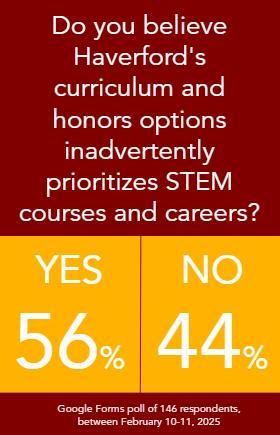

For the core English classes, however, there is only a .5 credit (half-year) honors class offered, in the first semester of Sixth Form. All other core English classes offered are at the standard level. And for history, only one core class—U.S. History—is offered at both the standard and honors-level.
Students can take advantage of 29 STEM-related electives in biology, chemistry, economics, and computer science, of which 11 are honors-level. There are ten humanities elective options, of which four are at the honors-level and none are in the English Department.
For students, yearly course selection includes not just picking classes but also taking into account the added layer of the college admission process. For students seeking admission to competitive colleges, expectations of those colleges must be taken into account when selecting courses.
What do colleges want? Academic rigor.
Rigor refers to the strength of a school curriculum, the most challenging classes available. At Haverford, the “most rigorous” classes are at the honors level.
The Common Data Set is created annu-
When explaining why there are no English electives, Ms. Smith-Kan explained, “English is the one subject that students are required to take for all four years. We are not trying to attract English students [with electives] because [students] have to take English.”
She concedes, however, that the lack of honors offerings for core English classes can lead to a perception issue.
“It kind of makes English feel, on the surface, less rigorous,” Ms. Smith-Kan said. “Kids [might] think, it’s not an honors class, so it’s not a priority.”
Smith-Kan also acknowledges that for some, English classes at the honors level could be valuable.
“When I was in high school, I started having an honors option as an 11th grader… It’s a great experience as an Honors English student to be in a room with others who are passionate about [the course],” Ms. SmithKan said.
Entering junior year, students selecting electives have six honors-level elective options in STEM, and none in humanities. All of the honors-level humanities electives of-
According to Ms. Smith-Kan, “English is not about one thing. In English class you can be talking about something really minute, like comma rules, or you can find yourself talking about life and death…English class is about life, people, human emotions, how you relate to others. It’s about empathy.”
“We read poems at people’s funerals. We read poems at people’s marriages. Literature is the thing we turn to in society when we have these big moments in life,” Ms. SmithKan said. “We look for interpretation in writing. It is the air we breathe.”
The current imbalance in Haverford’s course offerings highlights the deeper tension between the expectations of the college admissions process and broader education objectives of providing a varied curriculum. Haverford is the only independent school in the area not offering English electives, and comparing the Haverford curriculum to other independent schools in the Inter-Ac, like EA, Malvern, Baldwin and Agnes Irwin, and Germantown Academy, Haverford offers the fewest humanities options. Haverford dominates the Inter-Ac athletically; perhaps it should dominate in academic offerings as well.
Ben Qu ’28 and
Jayden Thomas ’27
The dust has settled, the gears have stopped spinning, and the echoes of cheering crowds have faded.
The Haverford School Robotics community can proudly reflect on a successful showing at the recent VEX High-Stakes Tournament at Conestoga School.
Five teams—169A, 169B, 169Y, 169E, and 169Z—battled fiercely against the top competitors across the East Pennsylvania region, demonstrating their skills in engineering, teamwork, and strategic thinking.
After qualifying matches, each team advanced to the elimination bracket. In qualifying matches, teams matched with another randomly selected team to compete against two other opponents. By developing an effective strategy, selecting specific autonomous routes, and organizing driver-control strategies, their hard work paid off. 169Z, 169Y, and 169E reached the Round of 16.
Notably, 169B reached the quarter-finals, and 169A advanced to the finals round and won the tournament championship.
The teams demonstrated a comprehensive understanding of the game strategy for this season’s challenge: scoring rings onto goals and stakes on the field.
This tournament wasn’t just about winning matches, it was a celebration of innovation, teamwork, and perseverance. After the competition, Haverford teams shared ideas, fine-tuned their designs, and analyzed game footage and strategy to refine their robots and competitiveness. Additionally, this large mid-season tournament allowed younger team members to gain valuable experience, learning from seasoned veterans and other team members and ensuring the continued growth of the Haverford Robotics program.
As they set their sights on the next competitions, one thing is certain: Haverford Robotics is ready to roll forward and overcome future challenges. The tournament provided a preview and insight into what would be expected at the state championship in March and gave a lesson to every one of the members.
William Komada ’28
Two weeks ago, the Model UN group gathered in Philadelphia for a three-day conference to discuss global issues with other high school students from all over the world. Haverford has competed in ILMUNC (Ivy League Model United Nations Conference) for fifteen years.
Fifth Former Ryan Shams has participated in Model UN in his first three years in the upper school.
“Good leadership and teamwork is key to success.”
RYAN SHAMS ’26
“Good leadership and teamwork is key to success,” Shams said. “Also, it is crucial to be clear and concise in the 60 seconds you have to deliver your speech.”
Shams researched air quality and environmental protection and regions of conflict, earning Honorable Mention. He thinks time management, teamwork, and speaking skills are all necessary to deliver a remarkable speech.
“Public speaking is a very important skill,” Shams said. “It is my third year do-
ing Model UN, so I felt comfortable and less nervous because I have done it so many times. However, you need to prepare a lot in order to find success. This year I spent about fifteen hours on the committee.”
Third Former Wilson Schiffer thinks Model UN representatives need to be dedicated, as conferences can be a significant time commitment.
“The overall experience was great. I met kids from all around the world and also made some friends. I found this experience helpful because I was able to go out of my comfort zone by speaking to many people,” Schiffer said. “It was a very long and busy trip. One of our conferences did not end until midnight. Even though I couldn’t get much sleep that day, it was worth it.”
Latin teacher Ms. Theodora Naqvi, one of Model UN’s faculty advisors, finds Model UN unique.
“It is different from debate because Model UN has a different goal and is less inherently competitive. Model UN is built around coalition building and teamwork,” Ms. Naqvi said. “The most valuable skill Model UN teaches you is to speak off the cuff and to react to the changing nature of the debate in the room. In high school, you are not often asked about big-picture topics in the world.”
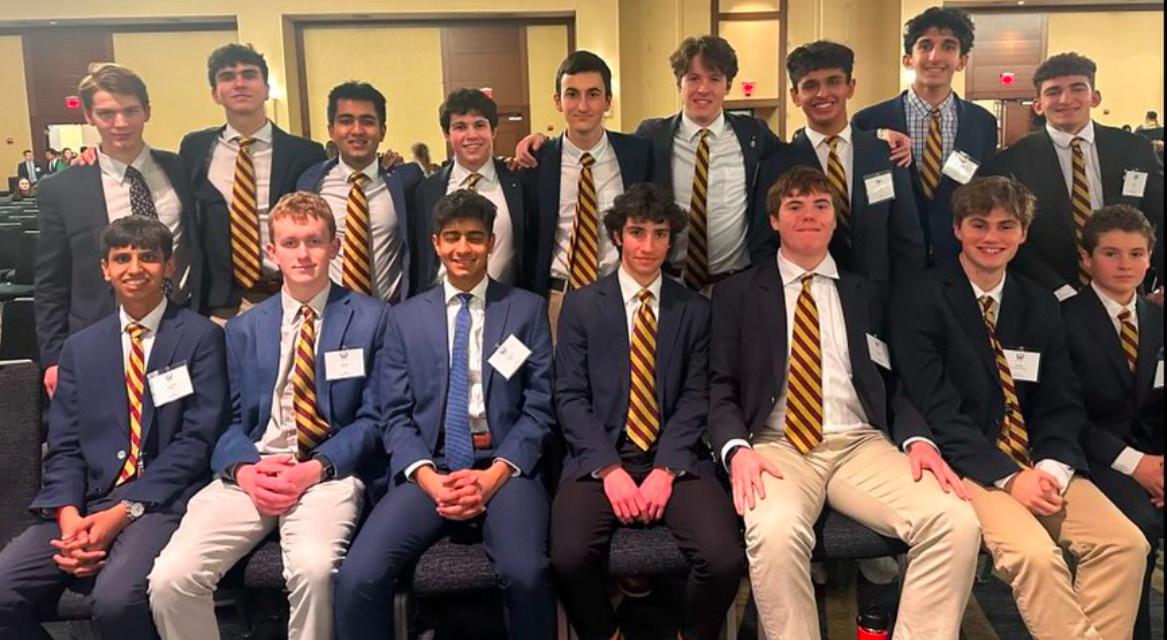
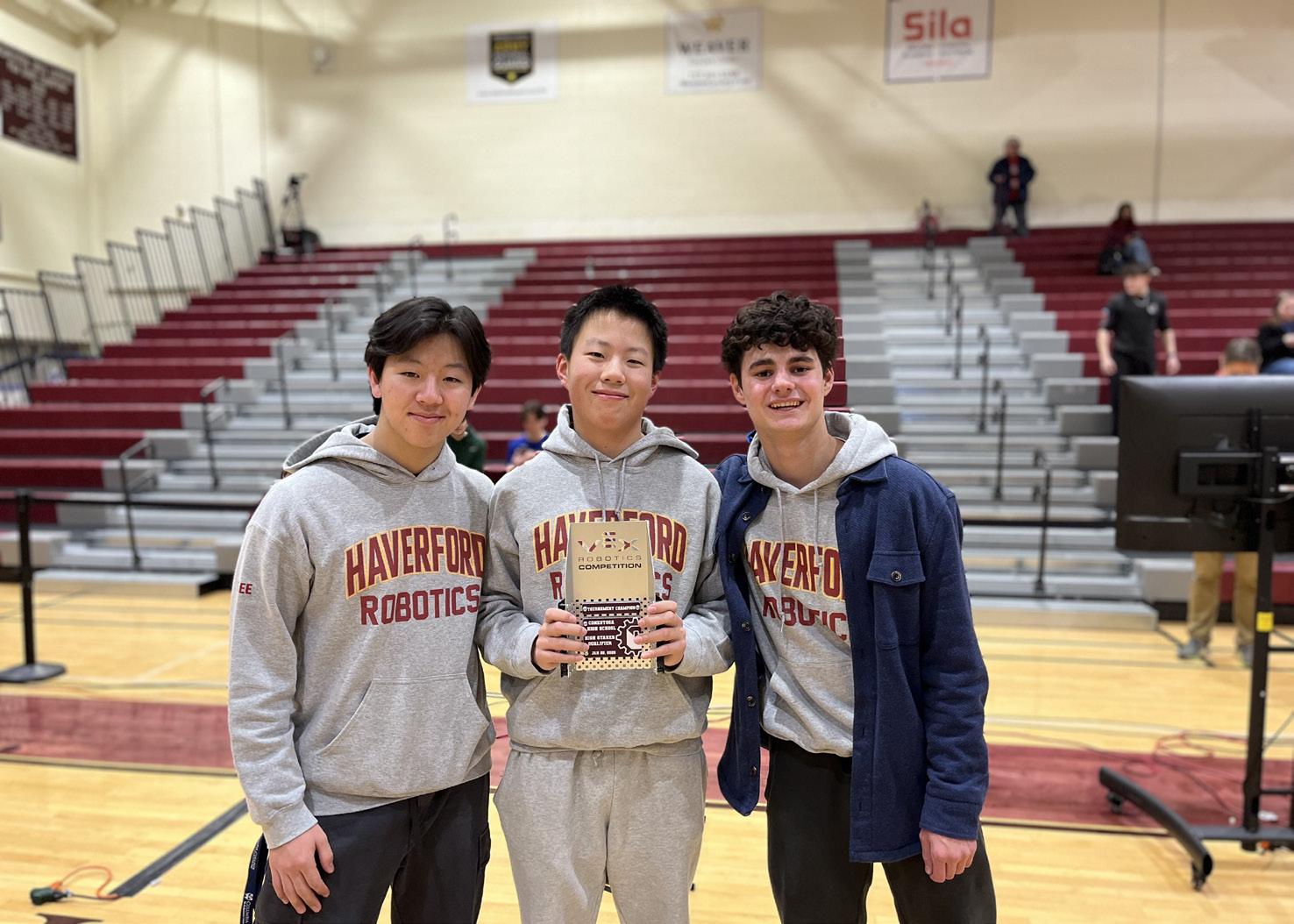
James MacColl ’26
The Wharton Global High School Investment Competition offers high school students the opportunity to create a unique investment strategy to manage a simulated portfolio using Wharton’s Investment Simulator.
What makes this program so unique? Teams are not deemed successful in the net profit they have generated from their investments, but rather from the quality and reasoning behind their investment strategies.
“Everyone had to dive super deep into the technical aspects of finance to make this possible.”
DREW CARRASCO ’26
Fifth Former Drew Carrasco and Sixth Formers Kevin Covington and Ben McDade each led one of the three Haverford teams in the competition. Carrasco’s team, The Fordman Sachs, advanced to the semifinals. Out of 1800 total teams in the competition, they were one of the 50 teams that advanced.
Making it to the semifinals was no easy
task.
“The hardest part of the competition, in my opinion, was getting a group of seven people together, all with different levels of education in finance, and all with different abilities,” Carrasco said. “Everyone had to dive super deep into the technical aspects of finance to make this possible.”
The Fordman Sachs compiled a fourteen-page report detailing the companies they would invest in, how much of the allotted cash they would invest into each company, and how these investments would prove beneficial for someone’s portfolio.
“After submitting the report and looking back on the long seven months that it took us to research, collaborate, and construct this portfolio, we got a very nice final product, and that was the most rewarding part of the competition—knowing that this was time well spent,” Carrasco said.
Although rewarding, The Fordman Sachs are not done with the competition. They are now creating a ten-minute-long presentation on their portfolio.
According to Carrasco, the teams “are trying to visualize all of the writing we did for our written report and make a very concise and eye-appealing presentation off of the information that we’ve gathered over the past semester.”

Awise man once said, “The sun was in my eyes, Astrid! What do you want me to do, block out the sun? I can do that, but I don’t have the time right now!”
To many of us, Snotlout Jorgenson’s words from How to Train Your Dragon are relatable in more ways than one. The sun will always rise in the east and set in the west. We still have Daylight Savings Time twice a year, and we still need to travel to school, even though the sun tries its best to stop us.
From my own personal experience on Lancaster Avenue, sunlight starts to distract me at 7:30 a.m. Even though I am sitting in the back seat, the glare is pretty obvious. As my parents start to drive slower due to lower visibility, I tilt my head down, using the brim of my baseball cap to remain in shade.
Sun glare affects not only drivers on the road, but also professional athletes trying to catch a touchdown pass to win a game.
Eagles fans were delighted in November as Dallas Cowboys’ receiver CeeDee Lamb lost track of the ball in the endzone due to the sunlight in his eyes. Later, Lamb commented to The Dallas Morning News that he was “1000%” in favor of installing curtains in AT&T Stadium to address the sun issue. Cowboys owner Jerry Jones, though, brushed off the thought.
Jerry Jones is not alone in dismissing issues like sun glare as a bad excuse, which


is why people rarely ever talk about it. It’s the sun, the big yellow orb floating in the sky for twelve hours a day. Sure, it gets in your eyes when you least want it to, but this inconvenience happens to everyone. People wear sunglasses and hats, and football players wear eye black. It didn’t help Lamb, but you get my point. Besides, it’s not like there’s a brightness setting that you can adjust to have a more pleasant driving experience, so you just deal with it. Sun glare is no big deal, right?
According to the National Highway Traffic Safety Administration, sun glare is not something we should shrug off. It contributes to 9,000 traffic accidents each year, equating to a third of all daytime traffic accidents. In Colorado, major roads are closed at specific times due to the blinding sunlight.
Teachers often have a story or two about their experience with sun glare.
“Sun glare is a problem every morning on my commute to school—as long as
Haverford’s sleek modern buildings provide an undoubtedly pleasant aesthetic, but decorations, especially thoughtful ones, complete a school.
How does Haverford decorate for the holidays, and how could the decorations be improved in future years?
Students around Haverford appreciate holiday decorations; many agree that decorations are beneficial, but could be greater in quantity.
“There should be more Christmas lights outside, not just in the building. There’s already a Christmas tree inside. I [also] wish there was more Christmas music,” Sixth Former Zac Fuscaldo said.
“I feel like there could be a bit more decorations around here, especially for major holidays,” Third Former Byron Yang said. “[It would be good] if we could have some kind of activity for students to help put up holiday decorations.”
The decorations, notably a Christmas
tree, Menorah, and Kinara were placed near the upper school’s main entrance. However, decorations are only as important when they are noticed: although set conveniently for visitors, some students were unaware of the decorations’ presence.
“Was there even a Christmas tree?”
Fourth Former Jayden Thomas said. “I don’t know.”
A lack of presence can lead to a lack of interest in decorations.
Some students are indifferent to decorations, though.
Fifth Former Andrew Witmer said, “I don’t care if there are decorations around the school.”
“I just like the holiday decorations,” Fifth Former Desmond Henecks added.
Some students believe that decorations benefit Haverford and provide improvements.
it’s a sunny day!” Science teacher Ms. Carol O’Brien said. “Since I come into school east on Lancaster, it can be quite a problem. The intersection of Pennswood Road is most challenging—it’s hard to see the traffic light at times.”
Music teacher Mr. Don Holdren avoids the road, but he doesn’t seem to have better luck on Montgomery. “I usually stay off of Lancaster Avenue, so that’s really not an issue for me. But mornings on Montgomery are terrible,” Mr. Holdren said.
“Thankfully, there are a lot of trees, so that does help, but in the places where there is no shade, it seems like the sun is directly in my eyes most of the time,” Mr. Holdren said.
Sun glare is unavoidable when driving to school, so what can be done to stay safe on the road? Mr. Holdren and Ms. O’Brien have some advice.
“I’m not sure what advice [I have] other than [to] wear polarized sunglasses and adjust the visors,” Ms. O’Brien said. “Avoiding
driving during sunrise and sunset isn’t always practical advice!”
Mr. Holdren adds, “It’s also important to drive carefully, be extra aware of your surroundings, and observe the speed limit.”
Pennsylvania State Police experts offer a great deal of tips for managing the sun on the road.
Clean your windshield weekly: a crystal clear windshield is less reflective. Sun visors built into cars also prove useful; they’re included for a reason. Invest in sunglasses, especially a polarized pair, since they significantly reduce glare. Both Mr. Holdren and Ms. O’Brien do.
Turning on your headlights can also help make you more visible to others.
If the situation on the road is simply too dangerous, though, pull over.
The sun shines regardless, so managing glare is always important. It’s always better to be safe than sorry, especially when driving.
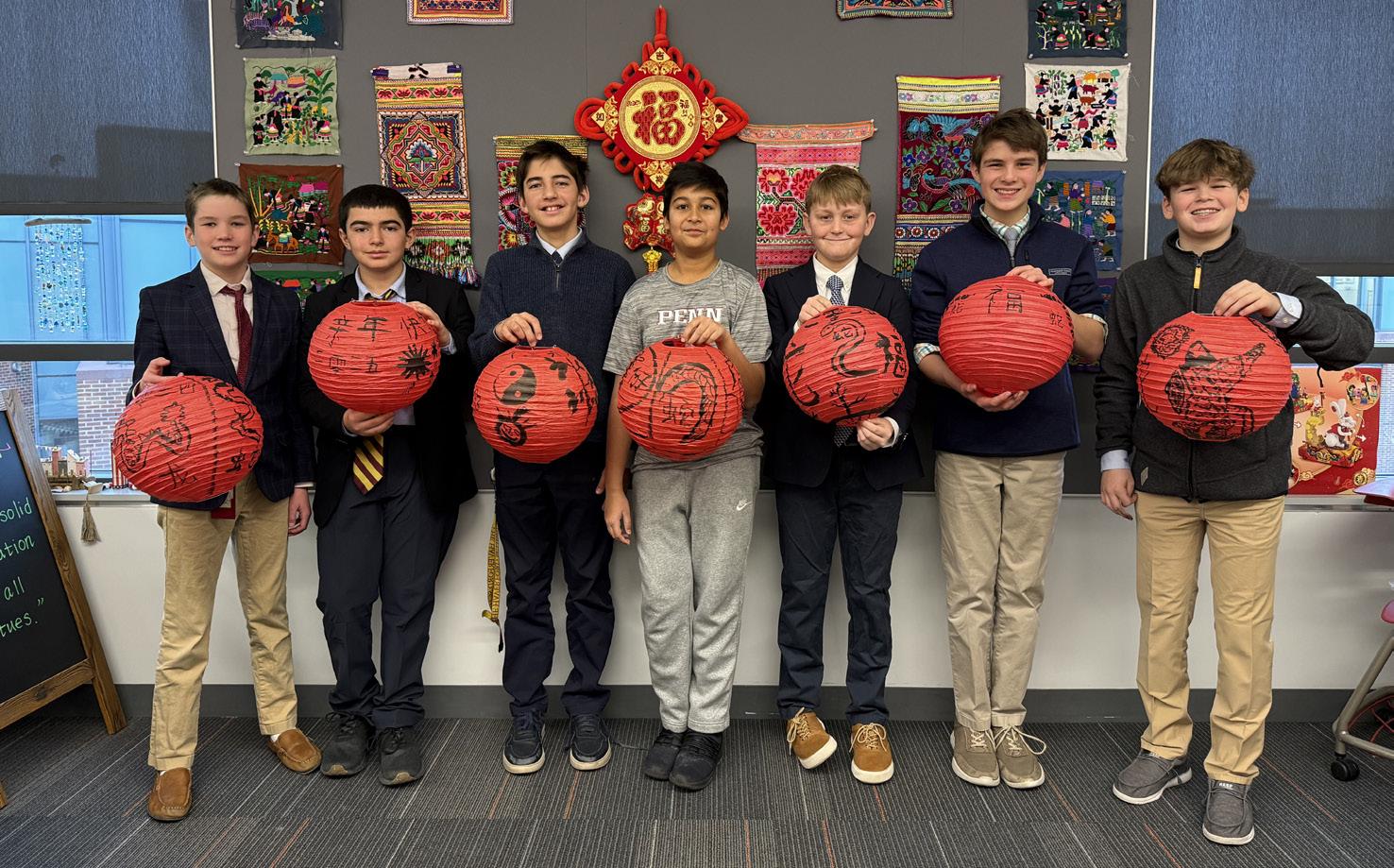
of the school is nice.”
in front
“Haverford is a school of many religions, so I think some holiday decorations are good,” Fifth Former Thomas Nye said. “I think having a
The holiday season has wound down, and the school has turned its focus away from decorations and returned to its system-
atic routine. But the question remains, will next year extend Haverford’s decorations to hallways, classrooms, perhaps all of campus? Only time will tell.
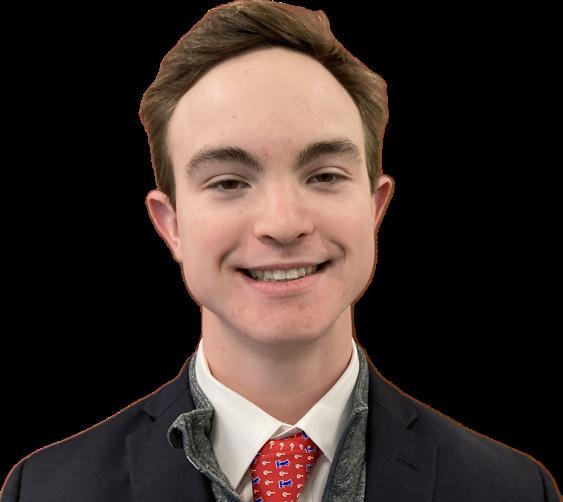
Peter mccconnell ’26
Sitting in Centennial Hall, many parents and some responsible students listened to college deans, directors, and officers remark on the admissions process, providing tips and tricks.
One speaker at the Tuesday, February 4th event wondered so many parents and so few students attended, when, after all, “the student is accepted to college, not the parent,” according to one speaker.
The question arises: how do we get more students to attend such a helpful event? While a portion of Centennial Hall filled, many students did not attend. Perhaps the Haverford versus Malvern basketball game played a role.
The value of supporting one’s school is important, and fans are crucial to the success of the Fords sports teams. Evidently, this is one of the highest priorities a Ford has.
College Counseling’s goal is always a higher level of attendance. “We certainly wish [attendance] was higher,” Director of College Counseling Mr. Damian Long said.
Given that the system, albeit well-designed, is not perfect, an announcement to people in the community of the presence of a case would not have only been warranted but expected.
When it comes to planning, College Counseling isn’t at fault. According to Mr. Long, this event was likely planned months
prior to the Malvern game. “We started planning in the summer…and we picked the date in early September,” he said.
Mr. Long explained that this program is part of “our first year returning to in-person events”—a change implemented to increase attendance. “The partnership piece was also new,” Mr. Long said, referring to the collaboration between Haverford, The Agnes Irwin School, and The Baldwin School.
Fifth Former Jay Tyson thinks he knows the reason why student attendance wasn’t so high: “Two other events on the same day… the Malvern game…and a dinner.”
Tyson noted that he “saw a lot more people” at a college counseling event in the fall, so he believes that the low turnout was simply due to the conflicting events.
As mentioned earlier, the college admissions process is designed for the student with parental support.
“These events are very deliberately designed to be student-centered, student-focused, with a parent playing a support role,” Mr. Long said.
But parents’ attendance was still higher than students’.
In an effort to raise student attendance, College Counseling has considered the idea of a mandatory event during the school day. But Mr. Long is hesitant to make the change. “Traditionally, College Counseling events have run in the evening so that both parents and students can hear the same information,” he said.
Mr. Long notes that the key is not “creat[ing] unnecessary stress,” because the office wants to avoid “interrupt[ing] the academic day.”
One might think that a virtual event would work better for attendance; however, according to Mr. Long, they didn’t.
It seems as though the event could and should have been better attended by those
just beginning their college search process. That timeframe could be anywhere from Fifth Formers beginning the process to others including the Fourth or even Third Formers.
The idea of doing something during the school day, such as a mandatory event, keeps Mr. Long and the College Counselling Office thinking. How can we get more students involved, potentially in a mandatory manner?
It seems that, while the event wasn’t necessarily all new information for Fifth Formers, it would certainly be helpful for Third and Fourth Formers—which is why the idea of a mandatory event shouldn’t be thrown away immediately for students’ benefit.
According to Fifth Former Jack Ford, the material discussed at the event was “pretty surface level,” so it would be a great event for “students who are just kind of thinking about the college process now or looking into it.”
“Obviously that was a great event for them and a great time for them to hear it from an admissions officer,” Ford said.
Tyson agreed, stating that everyone “had useful information to share,” however “it seemed more for beginners into the college search” which is “what we’re all, all of us [Fifth Formers], are kind of doing right now… but I know some people, me included, have already started working toward that.”
Tyson concluded that if it was “your first college counseling meeting or your first time starting the process it was very helpful.”
For someone like Ford, it was an opportunity to ensure that he knows and explores all his “options and opportunities.” Even though the material wasn’t all new for him, it was still a great resource and ensured that he is “well prepared and well educated,” which is his “number-one priority.”
Ford reiterated the value of having other grades, particularly Third and Fourth Formers, attend these events. “The focus was on [Fifth Formers]” because they are the ones who are applying to college, however “promoting this to all ages, but especially younger grades,” is the most important for this type of event, Ford concluded.
Tyson doesn’t necessarily think we need a mandatory event for everyone to participate in because “everybody’s at their different stages” and so therefore no one has to be forced into “learn[ing] something you already knew.”
Ford also mentioned how even the College Counseling seminars that students attend have information that could be valuable for younger students because someone like him has “already taken the SAT”—so therefore, this could be more beneficial for those outside of Fifth Form year.
Ford argued that if he had been introduced to College Counseling events at a younger age, he wouldn’t have had to “deal with these problems” in the summer and had to do his “own research” which was ultimately “more annoying than if somebody had done this” for him in the past.
Gaining an excellent student attendance is quite the balancing act, there are so many factors present to try and promote a healthy attendance level.

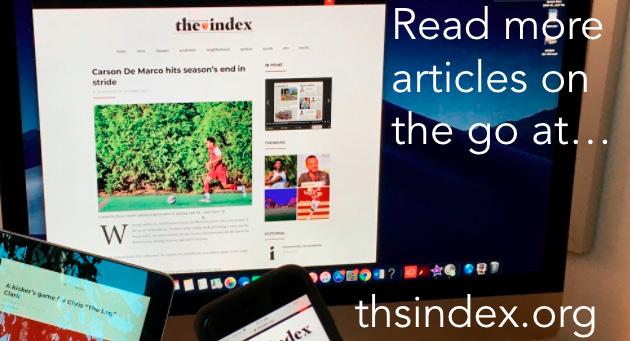
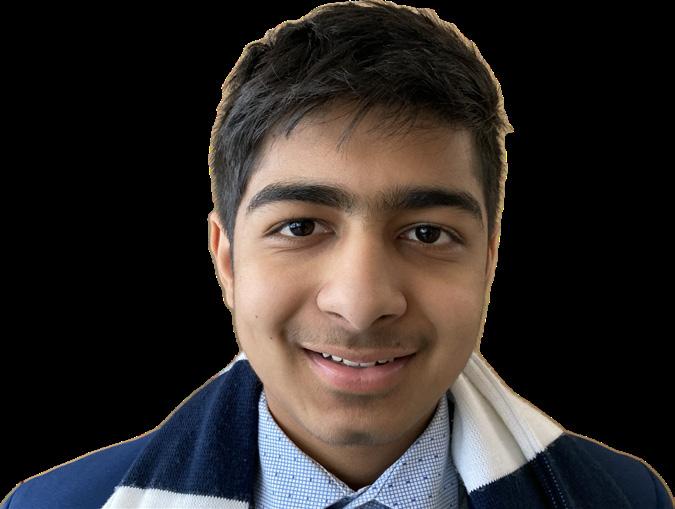
The average Haverford student tries to abide by the core virtues the school promotes.
Haverford students may be known as upstanding and respectful to those looking from the outside in; can the same be said from an insider looking within? With virtue supposedly in their hearts, why do Haverford men take such poor care of their home?
So many students come together to celebrate what they perceive as important— sports games, entertainment—but then fail to acknowledge other people’s priorities. Perhaps most students only do things for their own benefit.
Outside our locker room, where they brotherhood unites around a highly anticipated game, a quote reads, “Champions are made when no one is watching.”
Fords will go to a sports game for entertainment, to fit in, and to be liked, but then do not clean up the school because it is not their “job” to do so.
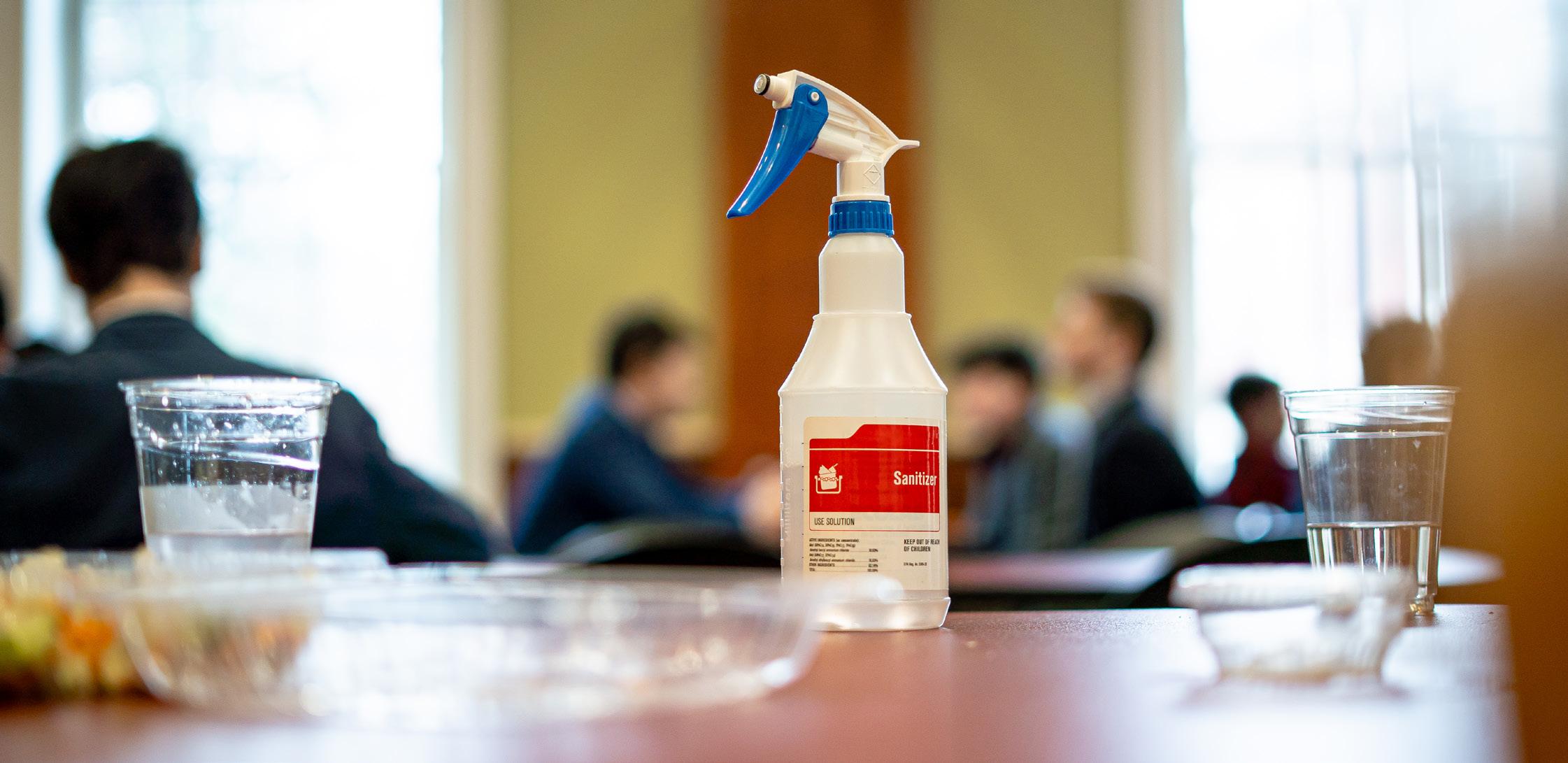
With no obligation, limited risk of getting into trouble, and no one watching, most students see no incentive to act. However, these very actions shape our character, our identity, and more importantly, our brotherhood.
This is specifically shown in the dining hall and in the Community Room where students often leave trash for someone else to pick up. The administration has taken note of this, enforcing punishment for this kind of behavior, by taking away the ping pong tables and some comfy chairs for periods of time.
Regardless of the punishment, students continue to do the same thing.
“It’s more than just kids not caring
about the spaces, they are not thinking that their actions have bigger impacts,” Dean of Students Mr. Luqman Kolade said. “The students do neglect to take care of shared spaces, despite our emphasis on honor and responsibility, but I think most of the time it’s unintentional.
A lot of the time kids are just careless, and some kids are used to people cleaning up after them in their own lives. Lastly, you also get people hanging out, then they realize they need to get to class and they leave their trash behind.”
Students have been found stuffing trash in between chairs so no one can see it.
Outside our locker room, where the brotherhood unites around a highly antici-
pated game, a quote reads, “Champions are made when no one is watching.” This quote attempts to remind us, students, that true character and integrity are demonstrated through our actions when there is no audience. It challenges us to uphold our values consistently, not just when it benefits us or when others are observing.
To paraphrase what the Head of Upper School Mr. Mark Fifer said at the Friday assembly reflecting on the Malvern basketball game, there are stereotypes that Haverford students are spoiled and arrogant, but we will never stoop down and respond to that level of disrespect because that is not what winners do.
You should be proud to be a Ford.
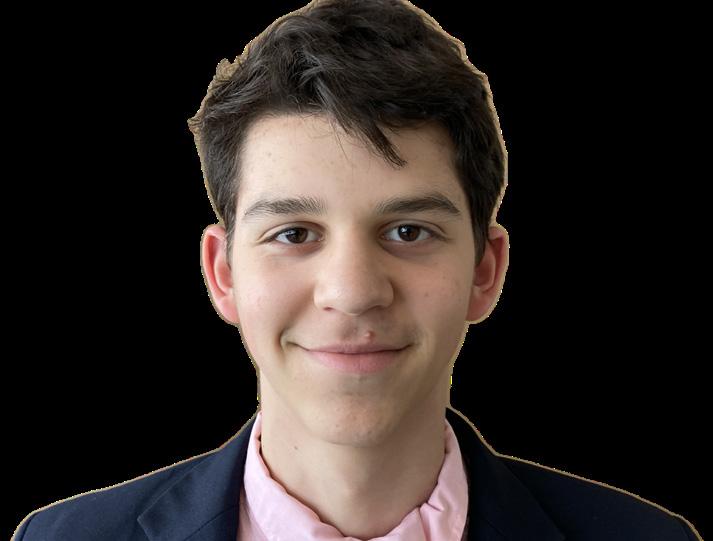
Midterm exams are inevitable. The second most dreaded assessment after final exams—some may argue the most dreaded, as an entire second semester looms—come on fast. Often, during midterms, especially in Fourth and Fifth Forms, students are tasked with studying an entire semester’s worth of old material, while still learning new material and attending class. For some, this, on top of projects and papers consuming hours and hours of time, is a recipe for a nervous
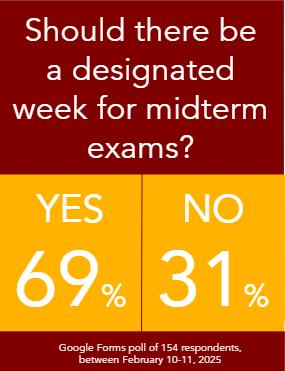
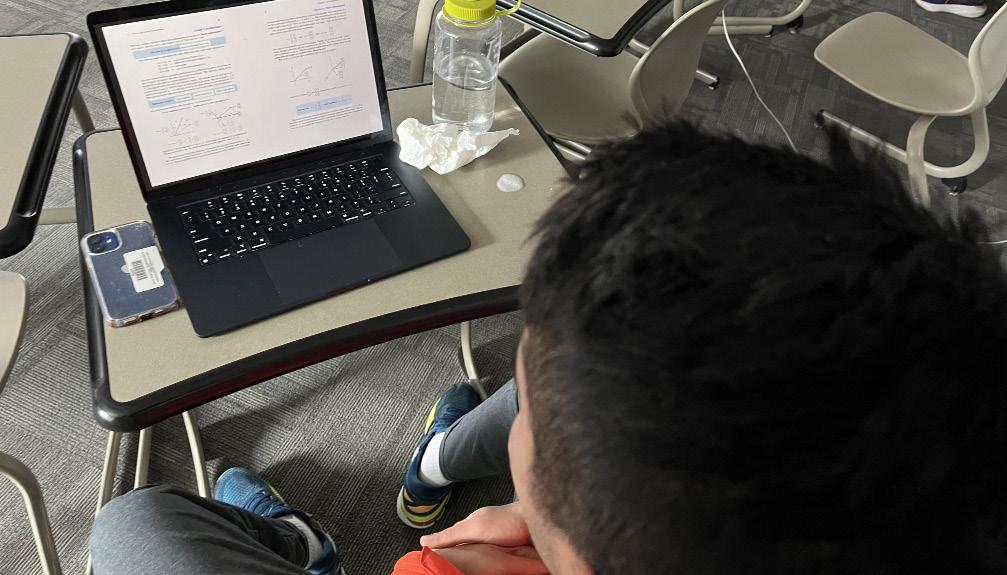
breakdown.
A properly designated midterm week, like that of finals week, should be implemented. A week devoted to no class, availing students of the necessary endless hours to properly study the endless piles of work. There is no difference in the amount of content contained in midterms and finals, so why are the conditions under which students must prepare so vastly different?
Fifth Former Colin Toth agrees.
“I think having a midterm week free of classes is a good idea,” he said. “We need the time to relearn the mountains of work from the first semester.”
An argument has consistently been made that teachers face pressure to get
through a dense syllabus, and therefore teach right up to midterms. To that end, there is a solution.
Should students lose the war for a midterm week free from classes, then a compromise can be reached: students should only be tested on that which they have not been previously assessed. Cramming in all the old information plus learning new information doesn’t fulfill the intended result of true comprehension or more learning. If the material was previously tested, then the teacher has hit the mark of teaching the material. Students likely have also written papers and taken tests on just that content; it’s time to move on.
“It’s a lot,” remarked Fifth Former Tom-
my Gowen. “[It] doesn’t make a lot of sense because we end up being tested twice on old material instead of once on a shorter amount of new material.”
Not to mention, the depth of engagement will be less for new material that has never been assessed.
If teachers want to assess all that students have learned and how well they've learned it, why not give them the opportunity to showcase exactly that? A reevaluation of both a class-free midterm week and the appropriate amount of content assessed should be considered.
Mental health and the price that is paid when it's under duress cannot be underestimated.
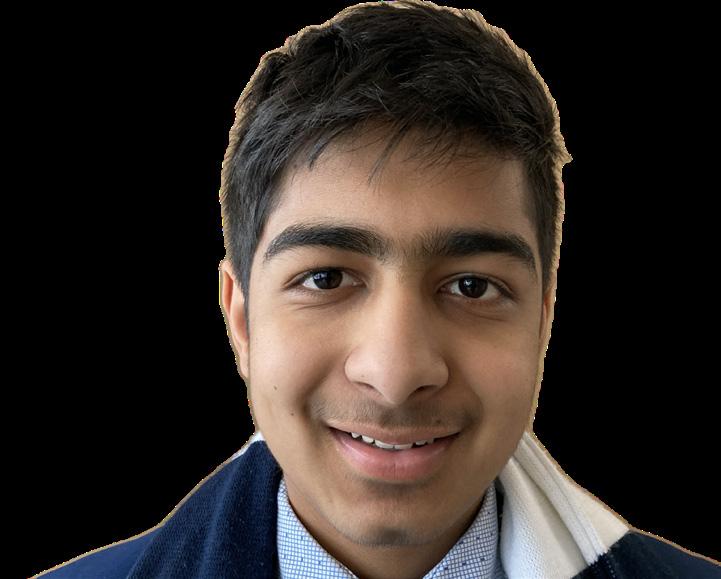
Ayush Varma ’27
Asmall government-backed company in China named DeepSeek recently shook the stock market. The largest ever market-cap drop in the stock market erased 589 billion dollars from the world’s most powerful company Nvidia (NVDA), a company that specializes in creating powerful futuristic computer chips and has, for the past two years, helped titanic companies such as Apple and Microsoft expand.
As NVDA’s market capital (a stock value calculation based on the number of shares multiplied by the price per share) greatly decreased, many other companies that NVDA impacts also decreased, including many companies in the tech-heavy NASDAQ 100 and some companies in the S&P 500. The NASDAQ 100 decreased by a little more than 3%, which is relatively large for an exchange-traded fund (ETF).
The reason for these drops is DeepSeek.
DeepSeek creates the same types of chips NVDA creates but for a smaller cost and fewer resources. DeepSeek has also created its own version of Chat GPT- R1.
Exactly how DeepSeek creates these powerful chips for a fraction of the resources is a mystery, but the company’s impact proves that there is still a massive market for AI development.
To see how such a small company affected the entire stock market, let’s rewind.
January 2025: DeepSeek released R1 at a fraction of the development cost and resources compared to Chat GPT. The small stock rapidly gained popularity and sent shock waves through the stock market, making investors panic and sell their stocks of NVDA, leading to a 600 billion dollar loss in market capital (how much the company is worth).
In the short term, this does not mean anything because NVDA’s assets, revenue,
and expenses are the same, but it can change how investors see the stock as weaker in the future. Deepseek has highlighted China’s growing capabilities in producing advanced AI technologies efficiently and has sparked debates about whether the U.S. can keep its competitive edge in the AI race.
Deepseek has seemingly proved there is a huge market for AI, and that the AI market can shift from immense companies in the U.S. to emerging companies in China, which explains changing global trade dynamics. Tariffs (trade restrictions on countries/groups) have been placed on China, but DeepSeek’s price efficiency, paired with the high demand for AI products, has made the tariffs on semiconductors in China unsuccessful. This may prompt the U.S. to reconsider its approach to its trade restrictions.
In response to the tariffs on China, China has imposed its own tariffs on the U.S. on coal, oil, farm equipment, and cars.
This tariff war, called the tit-for-tat strategy, leads to increased prices for all consumers. Along with the trade war with China, other countries such as Mexico and Canada have responded with the same strategy, doubling down on tariffs on the U.S. in response to President Donald Trump’s implemented tariffs in an attempt to decrease illegal immigration and drug trafficking.
Overall, the impact of AI cannot be understated. A single small company can influence entire economies and shape the information we access.
AI touches every aspect of our daily lives, from the apps we use to the way we learn and interact.
For students, understanding AI’s origins, goals, and purpose is crucial to fully harness its potential.
By staying informed about AI, students can better prepare for a future where technology plays an even bigger role.
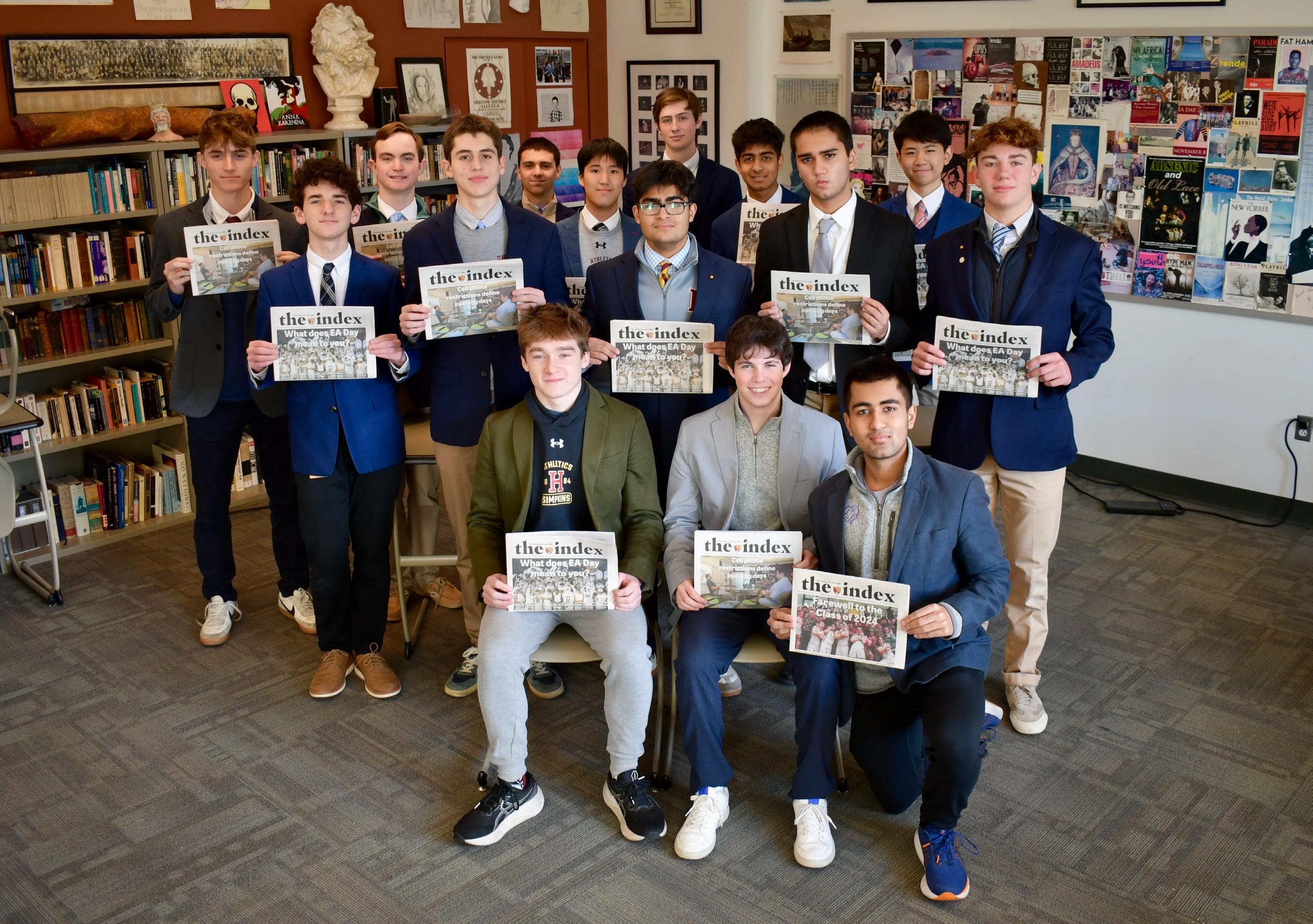
Ryan Wai ’25
Toothpaste drips from my mouth, I stare at myself in the mirror. Dark eye circles make me look like a zombie. The faucet squeaks as I turn it with my pinky finger. I can taste the cherry blossom toothpaste; I hear the squeal of the sink handle; I can see my zombie-like self in the mirror; I can smell the damp shower floor; I can feel the toothpaste running down my hand. My phone is in the bottom left corner of my sink as a TikTok plays repeatedly while I brush my teeth. I then walk downstairs to put the dishes away. Dishes in one hand, phone in the other. As I grip four dinner plates with my right hand, my left hand is holding my phone, playing some more TikTok.
The next morning, I wake up groggy, mid-dream. As my eyes are half-open, I force my hand to grab my phone. The first thing I always do in the morning is to grab my phone. I stare at my Sleep Cycle app in disappointment as it says I only slept five hours and twelve minutes. I bring my phone to the bathroom, scroll on Instagram while I use the toilet, and then go back on TikTok as I brush my teeth. Finally, as I put my phone away to put my school uniform on, a wave of regret hits me. Every day, I think to myself. I do this every day. I do the same thing every day.
Everything was rushed. I had to rush my homework. I had to rush to drive to school on time because I overslept, having stayed up late on my phone. Sometimes, I would do my homework for literally ten seconds, then go on my phone for an hour. When conversing with my friends, sometimes we would go on our phones in the middle of talking and get distracted. In a way, that angered me.
It started with Generation Z. Now it’s the most prevalent with Generation Alpha. I’m talking about what we like to call “iPad Kids.” I first discovered this phenomenon when I became one myself. I remember the first time I entered that Apple store in Markville Mall. I immediately ran over to the iPad section. I was sitting with all the
other kids, our eyes glued to the screen. I remember the faint background of chatter and footsteps as I played Fruit Ninja and NBA 2k14 mobile.
Last year, Cole Hastings uploaded a YouTube video exploring the “iPad Kid” epidemic. The video, titled “The iPad Baby Epidemic: A Generation Of Brain Rot,” goes on for fifteen minutes, talking about how Gen Alpha kids ruin their childhood. Hastings proceeds to talk about how iPad kids are getting more epistemic play and less and less ludic play. Epistemic play refers to the “phase of playing where the child collects knowledge and tries things out.”
On the other hand, ludic play is the “more innovative phase of playing where the child starts acting things out with the objects or symbols they are interacting with.” Historically, kids engage with more ludic play. For example, before I had a phone, I would build forts from sofa cushions with my friends during sleepovers. My creativity and innovation while building forts is an example of ludic play.
Hastings argues that with less ludic play, kids are growing up with less creativity during playtime than kids of previous generations. He cites that ludic play is essential for cognitive, emotional, and social development. Kids from Gen Z and Gen Alpha are developing a “consumption over creation” mindset.
Ever since I got a phone, my phone addiction has been getting worse and worse. My addiction started with using my phone one to two hours a day. As the years went on, that number would increase from three to four hours a day to four to five hours a day.
Now, I can’t do basic tasks without the accompaniment of my phone. Basic tasks such as brushing my teeth or putting the dishes away feel like an hour-long detention without my phone. I couldn’t understand why. It wasn’t like I wanted to do this. It just seemed like my phone was glued to my hand every day in my life.
Jeff Butler’s TedTalk references the criti-

cism that older people have been calling us “soft.” Our new generation’s phone addiction falls into the category of conformity. We feel the need to do everything our friends do. So when all of Gen Z and Gen Alpha society use their phones, we and our friends will probably pick up the phone as well. Butler says, “The first one is sociological, peer pressure; how many of you get frustrated when someone doesn’t respond to a text fast enough?”
Addiction has often been looked down upon. When you think of addictions, you think of drug addicts, alcoholics, gambling addicts, etc. These people are probably not the ones that have a lot of respect in society. Well, we kids are the epitome of addiction. We are more addicted to our phones than
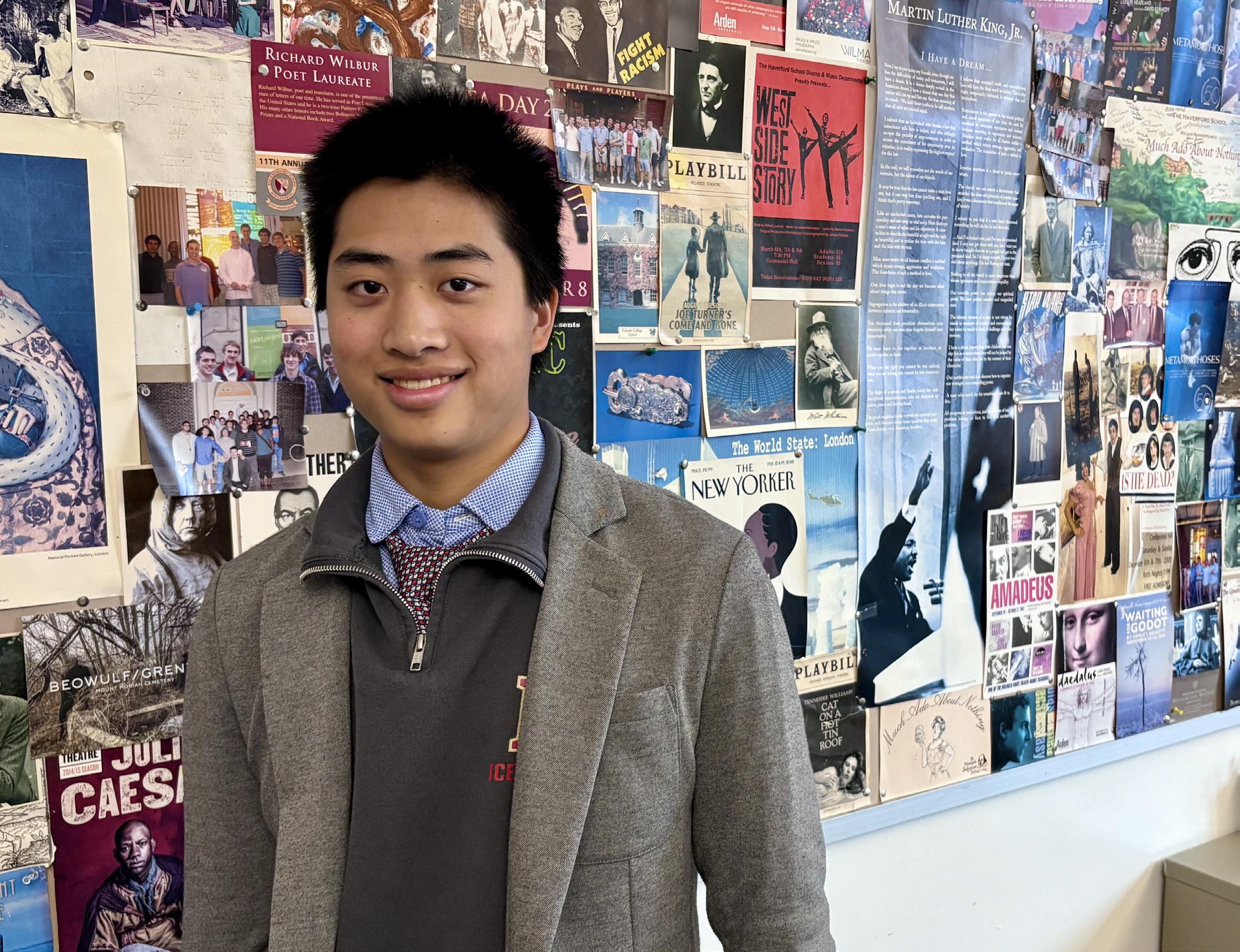
those guys are to their addictions. No wonder we keep hearing grandparents, uncles, and parents call us soft. We are just like those addicts. Except we are worse.
As I sat in my friend’s car to go to Dunkin this past week, I laughed when he started watching Instagram Reels in the middle of Lancaster Avenue. I couldn’t believe what I was seeing. Is someone more addicted to his phone than me? I couldn’t believe it. Why is it our generation? Why me? Why does the thought of a day without our phones send panic through our minds? Why, in a world full of wonders, do we choose to spend our time looking at a 6x3 screen? Why do we have to be the ones that suffer from phone addiction?
Often, I hear from adults that we are addicted to our phones. My parents, school administration, and hockey coaches all say the same thing.
But I understand it now. I can understand why the school wants to take our phones away, why they want to spend thousands of dollars to have us put phones in these pouches we all hate. I now know why my mom used to set all those screen time limits on my phone when I was younger. I understand why my father always called this 6x3 screen “The Little Monster.”
The truth is that phones take away from human interaction. They take away from our natural human element. They’re fun and useful sometimes. But they’re harmful. As Butler says, “Yes, the practicality that smartphones bring to our daily lives is phenomenal, but it comes at the price and near addictive behavior and the shortening of our attention spans.” Phones ruin us. They ruin so much of our lives and how we interact with others. Our lives are not the same with phones. Last night, I put The Little Monster away. Completely. I brushed my teeth without hearing “Brain Rot” coming from my phone. I put the dishes away with two hands this time, without seeing bitmojis pop up at the top of my screen. When I was brushing my teeth, I looked at myself in the mirror and it seemed like those eye bags were slowly disappearing. I was turning from a zombie back to a human.
I finally chose to live, not exist.
Recently, the middle school theater ensemble put on a production of the classic Disney musical, The Lion King JR. Over the years, they have performed several different classics, such as Shrek the Musical and You’re a Good Man, Charlie Brown
However, this year’s production of The
Lion King JR. was different from recent middle school musicals. It featured some students from the upper school’s musical, How to Succeed in a Business Without Really Trying including Sixth Formers Josh Williams, Aaron Bonaparte, Liam French, Luke Ganley, and Robert Goens; Fifth Formers Riyadh Rolls, Hezekiah Jones-Williams, Peter McConnell; and Third Former Kingston
Williams-Ekpaji.
This collaboration added a new level of depth and experience to the performance. The inclusion of high school students not only enhanced the “stampede scene” where Scar commits regicide, letting Mufasa fall into a herd of stampeding buffalo, but it also allowed middle schoolers to learn and grow from their older peers.

Atime-warping synth beats across the dancefloor, compelling her monsters to dance. Flickering lights obscure chiseled bodies as they lurch toward the pulsing, blood-red heart. Their grotesque lifeforms, vested in chains, lace, leather, and fur, live and breathe this moment. Waking up to the pearlescent full moon, they let out a guttural cry of hunger. The darkness of dance ignites a primal urge for movement. The monsters gyrate erratically—now set loose upon the stage to wreak havoc and spread Mayhem
Mother Monster, Lady Gaga, has returned to dance-pop after a decade of performing jazz, soft rock, and Americana; a Chromatica era hindered by COVID; and starring in several movies, including House of Gucci, A Star is Born, and Joker: Folie à Deux. This uncanny musical ghost sighting shocked the internet and the Grammys audience during a Mastercard commercial which, instead of featuring a cheesy ad about things that are “priceless,” debuted Gaga’s music video to “Mayhem.” The category is “Dance or Die,” Gaga announced, dressed in a pointy-shouldered, red leather, voodoodolled cloak and a large circular red hat resembling a prickly pear.
The album Mayhem is set to be unleashed May 7th.
“The album started as me facing my fear of returning to the pop music my earliest fans loved,” Gaga has said.
And her new music video does not disappoint; it’s completely different from anything she has ever done. The ensemble, dressed in bare white tops and matching
white leggings, contrasts Gaga, who evokes a bloody overseer of this deathly dance competition. Utter mayhem consumes the stage as bodies writhe in pleasure, and a haunting chorus of “AB-RACADABRA-ABRACADA-A-A-BRA” echoes across the floor.
The avant-garde Gaga of yore is back. She is no longer the fame-obsessed popstar alter ego bleeding out on the stage of the 2009 VMA’s; instead, she embodies the corrosive nature of fame and its casualties: blood, pain, and pleasure.
With her return comes the square wave synths and rhythmic spoken word refrains made iconic by “Telephone’s” line, “Out in the club and I’m sippin’ that bub/ And you’re not gonna reach my telephone (No)”. This more chaotic sound came to Gaga as she began to tap into her darker side, “searching for her inner demon.”
This past fall, Gaga teased her Halloween single “Disease” through a cryptic internet scavenger hunt, ending with its official release by Interscope Records on October 25th. The song centers around the Buddhist idea that “desire is the root of all suffering.” Gaga, who takes on the guise of a black bilespewing, raven-esque plague doctor, offers the listener solace in their sickness, singing, “Bring me your desire/ I can cure your disease.”
In an interview with Rolling Stone, Gaga said, “Disease is about facing the madness that resides within us… to fix this addict-like affliction that you have for [something].”
Gaga suffers because she wants what she cannot have, and judging by her new era, the only cure is dance.
The track is laden with simple repetition and danceable lines such as “Lay you down like one, two, three/eyes roll back in ecstasy” and “(Ah-ah) Screamin’ for me, baby/ (Ahah) Like you’re gonna die.”
Despite the positive critical reception, which praised the new sound as a return to roots, and Rolling Stone naming the song as the 17th best song of 2024, “Disease” did not make a large impact on the charts. It only reached the top 40 on Billboard Hot
“The experience was fantastic,” Williams said. “More than helping out, the best part was making connections with the younger grades. I don’t cross paths with the middle schoolers much, so it was awesome to be able to work with them on something special.”
The acting and music were strong, but so were the people who worked behind the scenes to put it together, like Technical Assistant of Centennial Hall Mx. Victoria Gill-Gomez, Director of Centennial Hall Mr. Dex Woodward, Middle School Theater Director Ms. Jennifer Hallman, Choreographer Ms. Dorothy Brown, and “Everything Manager” Ms. Rhonda Brown.
One of the most notable parts of the production were the costumes by Costume Designer Ms. Andrea Fox, who has produced high-quality costumes for the upper school shows as well. The middle school stage crew also worked hard to ensure the musical was perfect; some will even join the high school’s stage crew next year.
With the help of everyone on the cast and stage crew, the middle school produced a musical that impressed audiences.
“The performance was absolutely stunning. The integration of middle and high school students was super interesting,” Byron Yang ’28 said. “The middle schoolers did great, and I can’t wait to see next year’s production.”

100.
However, the charts were not out of reach, as Gaga’s duet with Bruno Mars, “Die With A Smile,” became her first top-ten hit in over four years since the 2020 release of “Rain on Me” with Ariana Grande. For “Die With A Smile,” Gaga and Mars took home the Grammy for Best Pop Duo/Group Performance.
While Gaga and Mars did not perform “Die With A Smile”—which won the grammy for best Pop Duo/Group performance that night—at the 67th Annual Grammy Awards, they sang a cover of “California Dreamin’” by The Mamas & the Papas in a tribute to the duo’s hometown suffering and recovering from the Southern California wildfires. Their voices blended together in a haunting call to action for climate justice. The Grammys generated over 24-million dollars in wildfire relief funds through a
partnership with the charity MusiCares.
In a twisted example of art imitating life, the LA Wildfires are an embodiment of Gaga’s Mayhem. In an interview with Elle, Gaga said, “It was hard at first to name the album Mayhem because I so much don’t want that feeling to be real.”
Through the process of dealing with her own personal mayhem, Gaga has hope for the recovery of her LA community through the benefits of music.
“I’m also somebody that is a dreamer, but what I think I ultimately arrived at is it’s all of the fractures of who we are and the fractures in the world and the mayhem of that brokenness that ultimately teaches us the power of joy, and dancing and crying and laughing and listening to music and holding your friends and your family and repeat!” Gaga said.
Fords Basketball has had a very strong season. Their record is now 20-4 and they are 5-4 in Inter-Ac games. There is one regular-season game left for them: Episcopal Academy on February 11th.
“I think the season is going well,” Six Former Kenneth Carson, Jr. stated, “It’s a good group of guys. We are better than last year.”
The Inter-Ac is changing. “Teams know each other better,” Head Coach Bernie Rodgers said, “It’s very heavily scouted now. The teams are balanced though. Every team also has a very good non-Inter-Ac record as well to show how good we are.”
“Every team is two plays away from the top and the bottom. Almost every game has gone down to the wire”
COACH
Fourth Former Silas Graham added to this description. “I think the Inter-Ac is really good and there is a lot of talent top to bottom,” he said, “It is definitely one of the toughest leagues in the area, and I feel that we have done a good job for the most part on figuring out ways to stay in games and find ways to win finish tight ones.”
Coach Rogers said, “We are a game out of second. Depending on our last two we could finish between 2nd and 4th. This is the deepest the Inter-Ac has been. Every team is two plays away from the top and the bottom. Almost every game has gone down

to the wire.”
Coach Rodgers also described how the team has changed. “We have changed the offense,” he said, “We have more guys between 6-3 to 6-5. This allows us to play more in the post. I think we can play faster this year with everyone gaining experience. To go along with that we are also much bigger with Manny and Duke back.”
Graham agreed. “We can beat guys up on the glass and use our size in the post when need be.”
The team has also dealt with many injuries this season. Sixth Former Kenneth Carson Jr, Fifth Former Dillon Gamble, and Fifth Former Emmanual Butts all missed several games due to injury.
“Guys have been ready,” Coach Rodgers said, “Different guys have stepped up when we need them to.”
Butts shared how he got back to form after his injuries.
“It definitely took a toll on me mentally.
But all the coaches, my family, my friends, my peers, and my form, the whole habit for school, community, and everybody outside of it supported me, kept me motivated, allowed me to, which allowed me to keep working hard at it and keep staying focused on a goal which is to come back better than ever,” he said.
“We were locked in.”
COACH BERNIE ROGERS
On February 4th, the team took on Malvern Preparatory School’s Varsity Basketball team. The Fords had lost their first matchup of the season by only two points, 46-48.
This time, however, things went differently, Haverford rocked Malvern and
won by 25 points with a score of 60-35.
“We were locked in,” Coach Rodgers said, “It was a pretty impressive game for us on offense and on defense.” Carson led the team with a 25-point performance.
“It was very good. I had lots of energy. The student section helped a lot,” Carson said.
Carson is also one of the players that Coach Rodgers commended for playing well this season. Graham, Butts, Gamble, and Sixth Former Duke Cloran also played well this season.
The team now looks to the future. “We are just staying locked in at practice all the time. We are remembering what we did wrong and how we can improve on that while also remembering all that we’ve accomplished this year and using that as momentum for the playoffs,” Graham said.
Coach Rodgers concludes, “We’re excited to finish this run and see what we can do in the PAISAA playoffs.”
As the Haverford School swimming and diving season nears its conclusion, the team is in a strong position, thanks in large part to a talented group of Sixth Formers. Their leadership, dedication, and standout performances have propelled the Fords to an impressive season, with key moments in both individual and team events.
With the final meet approaching, the team looks to finish strong, and all eyes are on Sixth Form swimmer Zach Oswald as he chases a school record.
For some, these final laps are more than just the end of a season—they mark the closing of a chapter filled with memories, growth, and camaraderie.
Sixth Form diver TJ Romero reflected on his journey, highlighting the joy of continuous improvement. “In a sport like diving where confidence is everything, learning a new dive is usually the highlight of my day,” he said. “I don’t think I can point to one moment.”
Oswald, whose sights are set on etching his name into the school’s record books, said, “Getting a school record to me means a chance to cement my legacy amongst the hundreds of amazing Haverford swimmers that came before me,” Oswald said. “The relay records are always the most fun to chase because it means four different guys all needing to do their part.”
Oswald also spoke about the usual team dynamic this year. “This team is definitely unique this year…a lot of our speed comes
from either the upperclassmen or the freshmen, which creates an interesting dynamic.
I think we’ve done a great job in building bonds with the younger swimmers and making them feel as much a part of the team as anyone.”
Sixth Former Will Suter reflected on the lessons learned and the bonds formed over the years. “My advice would be to buyin early. A lot of guys make it to championship season and wish they had been working harder all season.”
“We trained hard to win this meet and beat GA after losing to them early in the season.”
MASON MILLARD ’25
“Capitalize on the time you have early on in the season and try to enjoy those tough practices. With the season coming to an end, I feel pretty proud of what the team has been able to accomplish and the culture we have been able to cultivate. The swim and dive teams are definitely more united than they have been in the past. I am also realizing that I will definitely miss the team, as well as refining my diving skills and learning new dives as I move forward onto college,” Suter said.
Sixth Former Mason Millard echoed these sentiments, “We have had a pretty successful year so far and hope to finish it with a strong performance at the Eastern Prep Championship. We came into the season with our sights set on the Inter-Ac, but we fell short with an early loss to GA. However, after the loss, we bounced back and have won the rest of our meets, including the Inter-Ac Invitational.”
When asked about his most memorable meet, Millard pointed to the Inter-Ac Invitational.
“We trained hard to win this meet and
beat GA after losing to them early in the season,” he said. “We had a lot of guys qualify, including myself, for the Eastern Prep Championship at this meet. The team really rallied for each other, and you could see the whole team on the side of the pool cheering. We now enter into the final weeks of practice, preparing to continue our success at Easterns.”
As the season winds down, the seniors are leaving behind more than just records and wins—they’re leaving a legacy of unity, resilience, and passion that will inspire future Fords for years to come.
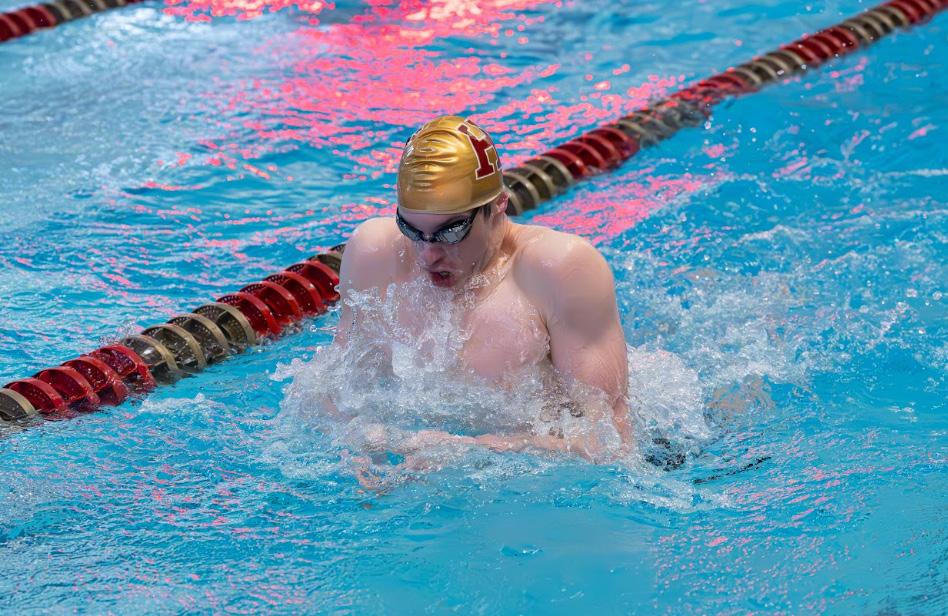
Rex Riley ’28
The 76ers’ season has not gone according to plan, but students wonder: Is it because of a lack of skill or a lack of effort?
The 76ers are currently the 11th-best team in the Eastern Conference. Many fans would consider this the worst place to be in the NBA, as a team does not have a high chance of making a deep playoff run and also does not have a high chance of winning the draft lottery for the first overall pick.
When asked if he only had one word to describe being a Sixers fan Third Former Luke Anderson said, “Being a Sixers fan is simply depressing.”
The main headlines about the team this season have been about the new arena that was supposed to be built in Center City, Philadelphia. These plans have since been cancelled, which has made a few Haverford students happy.
“I think that the stadium would have brought too much traffic to an already overcrowded city,” said Third Former Nick Canuso. Canuso isn’t the only student unhappy with the new stadium idea.
Third Former Danny Deering went as far as to say, “The stadium would have destroyed Chinatown completely.”
Others think that it would be nice to be able to take the train right to the 76ers
games.
The alternative solution is also not wellliked by students. The new plan is to build the stadium outside of Center City, in South Philadelphia. Many students think that this move is “a cheap fix.”
The stadium hasn’t been the only disappointment of this 76ers season.
The 76ers are in complete purgatory, and it is unclear what the team plans on doing in the future. The trade deadline has come and gone and the 76ers made no major moves. They traded Caleb Martin and K.J. Martin for cash and a few second-round picks.
These moves have not suggested they are trying to make a playoff run or if they are trying to rebuild and tank. The 76ers championship window is almost closed as they have two aging stars, Paul George and Joel Embiid.
Haverford students have vocalized their displeasure with the indecision.
Luke Anderson said, “They have to make a decision. Either go all in or tank for the draft. The worst place to be is the one that they are in now.”
Fans are frustrated and ratings are low. It’s going to be hard for Philadelphia to become full-time 76ers and Flyers fans in the next few days.
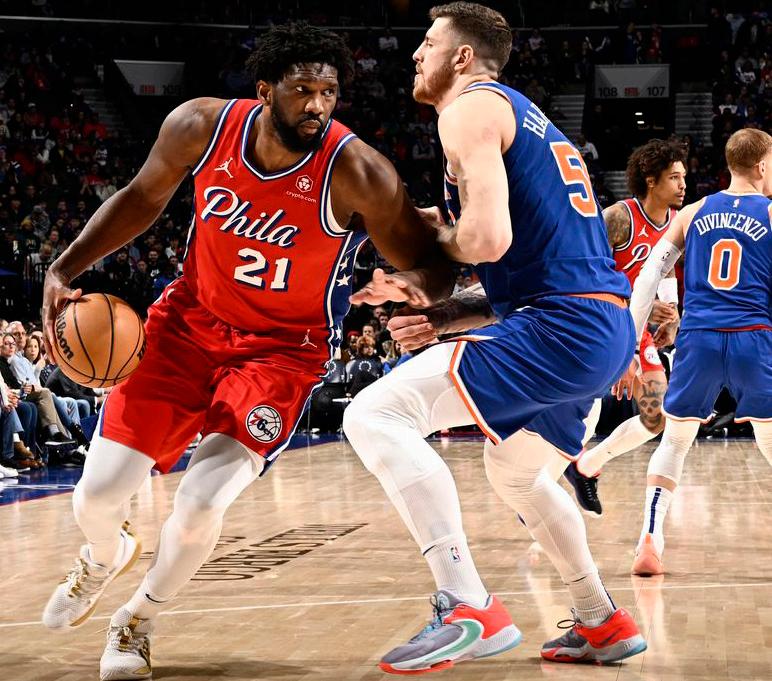
Nate Gill ’26
Starting off the season, the Philadelphia Eagles struggled. Falling to 2-2 on the season after a 16-33 loss to the Tampa Bay Buccaneers, the season was not looking great.
“I was a little worried. After the result of last year, two losses right out the gate did not look good.” Fifth Former Thomas Nye said. The Eagles then rose above the competition and proceeded to go 10-0 over their next games, beating playoff contenders, mainly the Baltimore Ravens and the Washington Commanders.
The surge was mainly due to the offseason work done by genius General Manager Howie Roseman. Roseman managed to secure running back Saquon Barkley, one of the best current running backs in the league from the conference rivals, the New York Giants.
Fifth Former and Giants fan Elliot Goodspeed feels the loss. “It hurts me,” Goodspeed said.
Barkley had an all-time great rushing season in NFL history, breaking the 2000yard mark during the regular season. He is only the 9th player to do so. Barkley scored fifteen touchdowns and had several massive plays including a backward hurdle over a defender and several long runs.
In addition to Barkley, Roseman pulled in Zach Baun, a player who no one would suspect would do well after his previous seasons with the New Orleans Saints. In his four seasons with the Saints, he had two sacks, and one interception, and had not forced any fumbles.
This season, he was signed out of free agency and then completed three-and-a-half sacks, one interception, and forced five fumbles on the way to being a DPOY Finalist.
“Highly impressive. I think what you see with Zack [Baun], is just a guy that is tough, physical, loves football. Great work ethic,” Eagles Head Coach Nick Sirianni said.
Roseman and the Eagles front office also drafted extremely well. They filled in one of the main gaps that the Eagles had in their defense at the cornerback position. At the 22nd pick, the Eagles snapped up Quinyon Mitchell from The University of Toledo. Mitchell proved that he was worth this pick as he allowed only 23 completions out of 41
attempts. Mitchell was roughly 4% better at preventing completions compared to Darius Slay and Jalen Ramsey, and his 5.2 yards per target is notably low.
Trading up to the 40th pick, the Eagles snagged Iowa Phenomenon Cooper DeJean. A fan favorite, DeJean has his own chant of “Coooop” which can regularly be heard at Lincoln Financial Field.
In addition to DeJean, the Eagles drafted Jalyx Hunt, Round 3 (Pick 94); Will Shipley, Round 4 (Pick 127); Ainias Smith, Round 5 (Pick 152); Jeremiah Trotter Jr., Round 5 (Pick 155); Trevor Keegan, Round 5 (Pick 172); Johnny Wilson, Round 6 (Pick 185); and Dylan McMahon, Round 6 (Pick 190).
After powering to a 12-3 record, the Eagles had a rough change: in their game against the Washington Commanders, star quarterback Jalen Hurts was hammered into the ground and suffered a concussion. The Eagles fell to the Commanders after the Commanders scored with six seconds left, giving them a lead.
After this heartbreaking loss, the Eagles walloped the Cowboys, 41-7. Then, they matched up against the Giants, Barkley’s former team, for the second time, winning while resting the majority of their starters for the playoffs ahead.
Throughout the season the Eagles’ defense proved their supremacy in the league and improvement since last year. Last season, the defense let in 25.6 points per game; this season, the defense dropped that number by over a touchdown to a league-best 17.9 points per game.
They held offenses to 278.4 yards per game, allowing only 4732 yards during the whole regular season. The second-place team, the Houston Texans, allowed the equivalent of another game’s worth of yards over the season.
The Eagles impressive 14-3 record scored them the second seed in the NFC.
“I felt great about the Eagles going into the playoffs. The offense and defense both looked stacked,” Fifth Former James Friel said. “Best Eagles team I’ve ever seen.”
The Eagles matched up with the Green Bay Packers, and due to their higher seeding, had a home game at Lincoln Financial Field. The Eagles worked through the Packers, earning a 22-10 win.
“I was psyched. I felt pretty good about
the next month of games,” Fifth Former Peter McConnell said.
Next, the Eagles matched up with the Rams in the Divisional Round. In a snowy game, the Rams started to feel the cold and gave up a few costly turnovers. The Eagles powered through the rest of the game to win 28-22.
In the NFC Championship, the Eagles had a rematch against the phenomenal rookie Jayden Daniels and the Washington Commanders. Still feeling the sting of their loss in Week 16, the Eagles were ready to go. The Commanders continued to struggle against Barkley, and he continued to run rampant among them. After the Commanders wandered down the field and popped in a field goal, Saquon took the first play to the house with a 60-yard touchdown.
“It was crazy. First play of the game and he was gone,” Fifth Former James MacColl said.
The Eagles’ offense continued to churn down the field whenever they had the ball. The Commanders turned the ball over four times and the Eagles capitalized on each opportunity. After seven rushing touchdowns, the Eagles won the NFC Championship Game with the most points ever in NFL history: 55-23.
With the win, the Eagles earned a spot in the Super Bowl. Their opponents, the Kansas City Chiefs, had earned several narrow wins this season.
Coming into the game, two questions loomed for the Eagles: Could the Chiefs limit Barkley? Could the Eagles defense stop Mahomes?
The Chiefs held Barkley to just 2.3 yards per carry. However, he set the unofficial record for most yards, breaking Terrell Davis’s record of 2476 yards in 1998. Barkley ran for 57 yards in the Super Bowl to give him 2504 rushing yards on the season.
With the Chiefs’ defense dedicated to stopping Barkley, the passing game had free reign over the field. Wide receivers A.J. Brown, Devonta Smith, and Jahan Dotson and tight end Dallas Godert caught passes for several yards, and Brown and Smith scored touchdowns.
Hurts also scampered for two runs and pounded in a touchdown with the overpowered tush push. The Eagles finished the first half with an impressive 24 points.
On the other side of the ball, the Chiefs
finally met a good defense. The Eagles’ fourman front line began trashing the Chiefs offensive line, forcing Mahomes to throw fast. The Eagles’ very strong secondary held all of the receivers in check, locking down the Chiefs’ offense. As Mahomes struggled to get an offense going, the Eagles forced sacks on consecutive drives crushing all hopes of rhythm. A pick-six from Dejean had the Chiefs stumbling, and an interception inside the Chief’s ten-yard line by Baun forced the Chiefs into chaos. Tight end Travis Kelce and wide receiver Deandre Hopkins both dropped passes, and the Chiefs had only 23 total scrimmage yards in the first half.
Fifth Former Harrison Cross attended the Super Bowl.
“It was crazy. There was not a chance that we were going to lose after that first half,” Cross said. “Mahomes is not built like Tom Brady and could not pull off a comeback like that.”
He also spoke about the state of Caesars Superdome.
“It was insane. [Caesars Superdome] has a capacity of 65,000 but it felt like a whole lot more. There were also a ton of Eagles fans. When the Chiefs ran out, they got booed. Mahomes received a ton of boos and the refs as well. The first penalty on A.J. Brown had people chirping the refs,” Cross said.
In the second half, the onslaught continued. The Chiefs forced a three-and-out and then had a pass for a first down. However, the Eagles defense cracked back down and began beating them back again. After more sacks, the Chiefs went for a fourth down conversion and the ball got swatted. The Eagles offense began cruising down the field and kicker Jake Elliot scored several field goals.
After the eight-minute mark in the fourth quarter, with the score 37-6, the Eagles began to play without the same intensity. The Eagles scored one more field goal while allowing the Chiefs two touchdowns. And then the game was over.
“It was pretty great. Especially since we lost to the Chiefs two years ago in the Super Bowl. A great game to show that we were on top considering that we had a rough start to the season and collapsed last season. I was glad to see Saquon and Hurts get a win. Hurts is constantly over-hated and underrated,” Cross said.
Closing in on the last few games of Head Coach Thomas Lindberg’s fourth year overseeing the hockey program, the team has experienced a period of both extended success and learning.
Finishing as IHL champions last year, the Fords have moved up a division to the ICSHL and taken the ice against more challenging competition.
The boys are buzzing and are ready to be back in action as they took a tough exit out of the state championship last fall.
While consistently beating rivals, including EA, over recent years, the team has overseen a youth movement headed by Coach Lindberg’s improved recruiting efforts.
Playing scrimmage games against eighth-grade teams to build recruiting pipelines, the Fords are now composed of a competent young roster highlighted by its two goalies, Third Formers Ike Matoney and
Liam McGrath.
Sixth Former Pat Cohen, one of only three Sixth Formers on the roster, occupies a leadership role on the team.
“It means a lot,” Cohen said. “I’m helping write a second book.”
The “book” Cohen refers to is the story of Fords’ hockey in their new league.
Writing a chapter in each of the last three years in the IHL, Coach Lindberg has called on the team to use their promotion as the genesis of their next story.
Part of the Fords story this year has been playing in front of student fans.
“It means everything to play in front of your brothers,” Cohen said. “We’re almost undefeated with a student section… It gives us that extra energy we need to make those crucial plays.”
What’s most impressive about student attendance at games this year is the team’s full-time move to Ice Line in West Chester, 40 minutes away from campus.
Despite the distance, senior night brought a large crowd and a Fords win.
Looking to the end of the season, players are hoping for playoff glory.
“If we win the next two, it gives us a

good chance of making the Flyers Cup.
That’s our goal,” Cohen said.
Besides the coveted playoff success, it would put the program in a stronger position to attract talent and build on past improvements.
When asked to reflect on his four
Grayson Morgan ’26
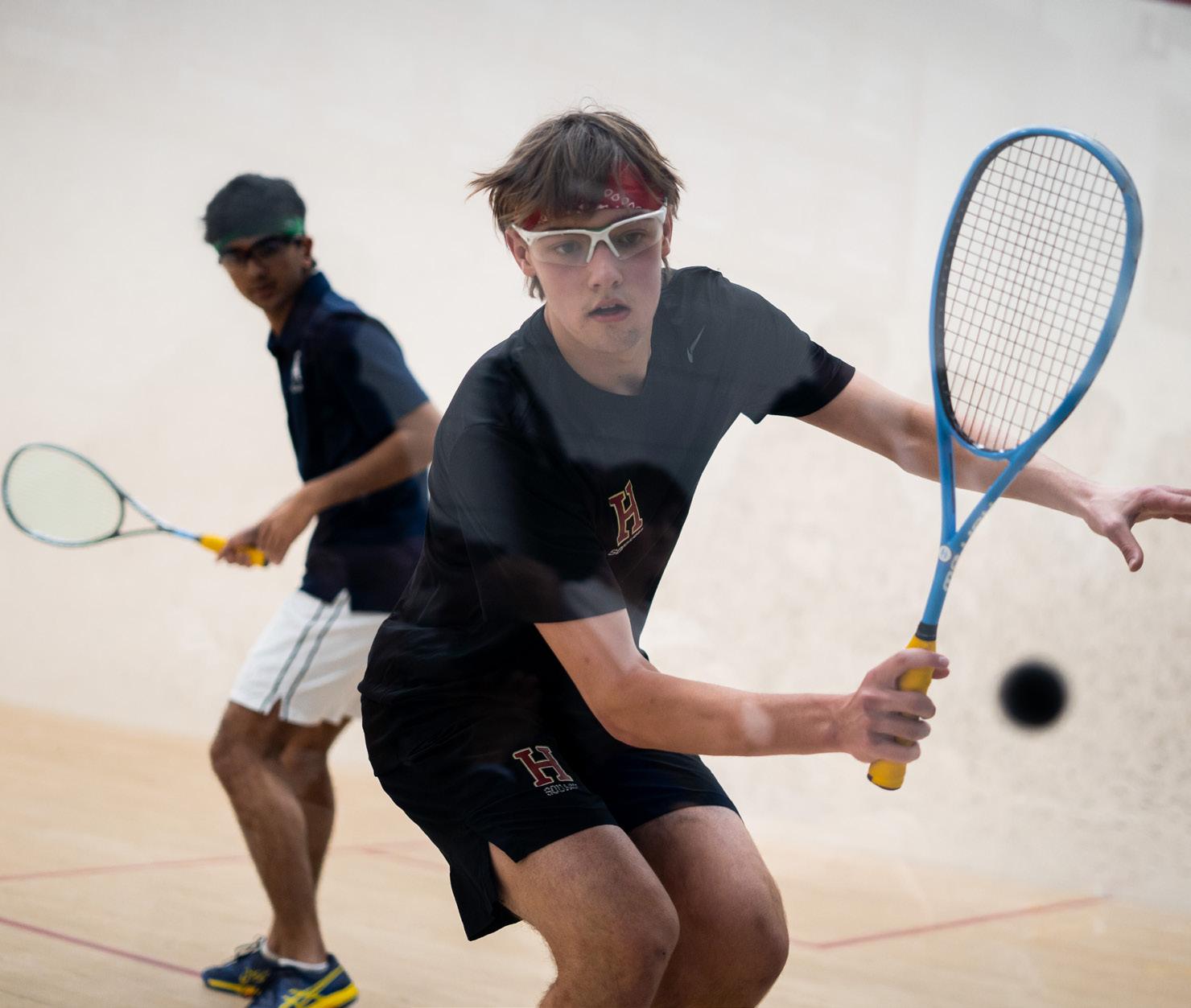
Tchampion Epis-
copal Academy on January 30th to clinch the 2024-2025 Inter-Ac title.
This triumph, in the biggest match of
the season, comes as a perfect farewell gift for Sixth Form captains Jamie Stait, Devon Li, and Xan Matuch, after the team lost the title last year in a thrilling, yet heartbreaking 5-4 showdown.
“On the day, I was really impressed with how the boys dealt with the pressure and even the ones that didn’t win their matches executed their gameplans and made it tough for our opponents.”
COACH ALEX STAIT
Stait said, “I think that this was the pinnacle of our season. The match really brought together the hard work we put in and the dedication that we have brought to training this season. We had eighth graders to seniors competing, and it took everyone’s effort to reach that goal. It was one of the best days in my Haverford squash career and
The wrestling team has found a new source of inspiration and strength through the newly acquired Coach Christopher Kober ’17. Coach Kober is a former college coach and wrestler who has brought a unique and impactful coaching style to the team.
“He treats us like family.”
MATT HOBAN ’26
“I feel like he really holds us to high standards,” Fifth Former Matt Hoban said. “He treats us like family, and he really cares a lot about each and every one of us. He wants us to do the best that we can.”
This sense of connection has been crucial for the team this season, and with Coach
Kober’s ability to relate to the wrestlers, having been in their shoes once before, one can know that the wrestling team is going to be a strong contender for titles in future years.
The team as a whole is young, with many Third and Fourth Formers, promising a strong future. Throughout the season, all of the boys have shown significant growth and are determined to become better wrestlers. Although the team placed third at the PAISAA Duals, a step down from last year’s performance, the wrestlers are on an upward trajectory. As the team enters the final stretch of the season before states and national preps, the boys remain focused on one key goal, winning and making the podium.
Hoban said, “Like Kober said, he knows we work the hardest out of any team that we compete against, so we should be ready for the challenge of states and national preps.”
years on the hockey team, Cohen advised the young skaters to focus on effort, “Give 110% each practice. You can always get that 1% better.”
I’m thankful to have been able to spend it with this group of teammates.”
Head Coach Alex Stait reinforced Stait’s sentiments, expressing his satisfaction with the team’s hard work and accomplishments this season thus far.
“The main goal of our season has been to recapture the Inter-Ac. We narrowly beat Episcopal in the last match in the final of MASA and knew that the match this time around would be a 50/50 contest,” Coach Stait said. “On the day, I was really impressed with how the boys dealt with the pressure, and even the ones that didn’t win their matches executed their gameplans and made it tough for our opponents. Winning MASA and the Inter-Ac is a huge achievement and just reward for all the players, especially the three captain seniors who have been outstanding performers over the years for the team.”
Still, the work for this Fords team is not yet complete.
Li said, “The job isn’t finished. The next goal is a national title or at least a strong showing on the biggest stage in high school squash.”
The Fords squash program now sets its sights on the National Championships in February, where they expect to be a top-eight seed.
